Elizabeth Arden (1930-1945)
Continued from: Elizabeth Arden (1920-1930)
Continued onto: Elizabeth Arden (post 1945)
In August, 1929, Elizabeth Arden leased part of the ground floor and five upper floors of the Aeolian Building at 689-691 Fifth Avenue. A black, marble storefront designed by Mott B. Schmidt [1889-1977] was installed at the north end of the Fifth Avenue facade along with the signature red door, and the new salon opened in January, 1930.
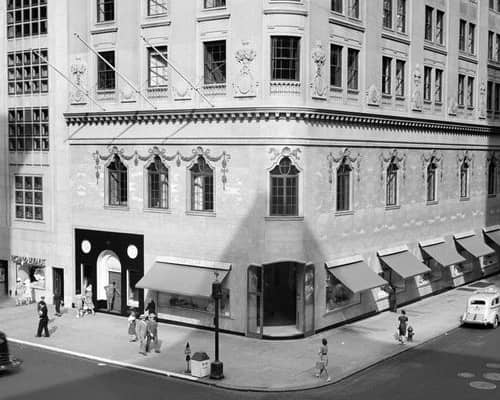
Above: 1939 Entrance to the Elizabeth Arden salon at 691 Fifth Avenue. Arden would buy the whole building in 1944. Richard Hudnut opened next door in 1931.
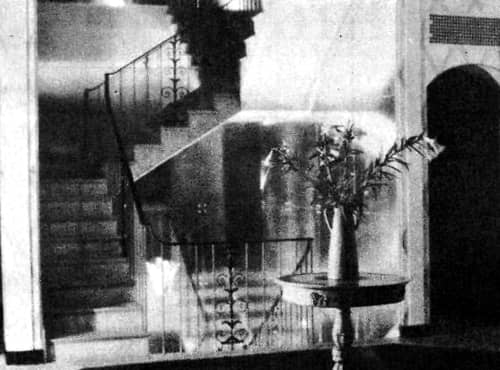
Above: 1931 Main staircase in the Arden salon on Fifth Avenue.
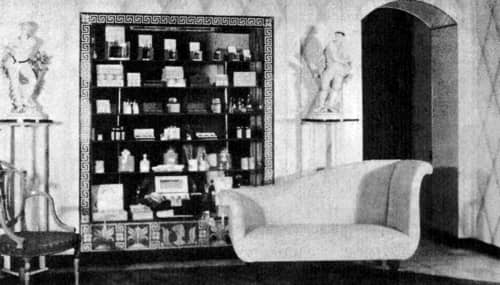
Above: 1931 Reception room with Arden cosmetics on display in the Fifth Avenue salon. The interiors were designed by Luritia ‘Rue’ Winterbotham Carpenter [1876-1931].
Arden liked Schmidt’s design and used it again in her new salons at 251 South 17th Street, Philadelphia and 3933 Wilshire Boulevard, Los Angeles, both opened in 1933.
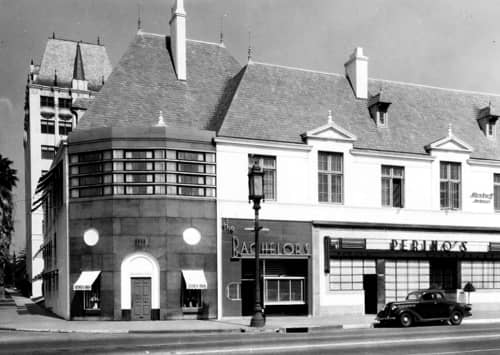
Above: 1940 Entrance to the new Elizabeth Arden salon in Los Angeles using the design first used in New York.
Schmidt was also commissioned by Arden to design a new, six-story building with a purpose-built salon in Washington, D.C., built on the site of her Connecticut Avenue salon. She had bought the building in 1929 and then demolished it. The new salon opened in 1930 and remained there until 1990.
The decisions to move the New York salon to Fifth Avenue and to buy the Connecticut Avenue site were taken before the stock market crash of November, 1929 but the new salons in Washington, Philadelphia and Los Angeles were constructed as the Great Depression was deepening. This might give the impression that Arden’s business was largely unaffected by the adverse economic conditions but this was not the case. The deepening depression saw Arden reduce her prices more than once and she also introduced cut-price salon treatments for the more budget conscious.
The depression may have also been partly responsible for her establishing two new European subsidiaries – Elizabeth Arden G.m.b.H. at 20 Budapesterstrasse, Berlin and Elizabeth Arden S.A.I. at 62 Via Veneto, Rome – in 1934. They would have helped counteract the new import duties, exchange controls and quotas imposed by countries trying to protect their local industries during the downturn.
Arden also opened new markets for her products during this period, establishing Elizabeth Arden (South America) Inc. in 1935. This Delaware company was given permission by Brazilian and Argentinian authorities to operate in Rio de Janeiro and Buenos Aires and Arden was doing business in both places no later than 1936, a number of years before Helena Rubinstein set up there as well.
Divorce
During this difficult time Arden’s husband, Thomas Jenkins Lewis [1877-1971], was managing the wholesale side of the business, a position he had taken up after he married Arden in 1915. This ended with his separation from Arden in 1933. Lewis and Woodworth (1973) list two events that triggered the separation and eventual divorce. The first, was an attempt by Tom Lewis to cut Arden out of some important business decisions. This may have seemed wise in the deteriorating economic climate – given Arden’s headstrong and erratic nature – but it was not prudent. The second, was an alleged affair between Tom Lewis and an Arden employee named Mildred Beam. The supposed infidelity was made worse when Mildred left Arden to start her own beauty business under the trade name Jane Cloud.
See also: Jane Cloud
The departure of Tom Lewis in 1933 – followed by the divorce in 1934 – removed a constraining influence on Arden and she made a series of dubious business decisions in the years that followed. Leaving to one side her disastrous marriage to Prince Michael Evlanoff [1894-1972] in 1942 – which seems to have been fuelled by Helena Rubinstein becoming Princess Gourielli through her marriage to Prince Artchil Gourielli-Tchkonia in 1938 – three examples come to mind.
Radio: Overriding all advice to the contrary, Arden decided to sponsor a radio program on NBC. Elizabeth Arden was not a mass-marketed brand so radio was not a good fit. Arden’s constant meddling created numerous problems and ensured that nothing went smoothly. By the time the program was cancelled it was believed to have cost the company US$200,000 (Lewis & Woodworth, 1973, p. 170).
Screen and stage: The purchase of DeLong Laboratories Ltd. in 1935, and the subsequent rebranding of its Nuchromatic range as Screen and Stage Make-up, was another loss-making venture. The movie industry showed limited interest in it and the make-up was too heavy for general use. The introduction of Max Factor’s Pan-Cake Make-up in 1937 – released for general use in 1938 – killed off any hope for the range and it was quietly shelved after considerable losses.
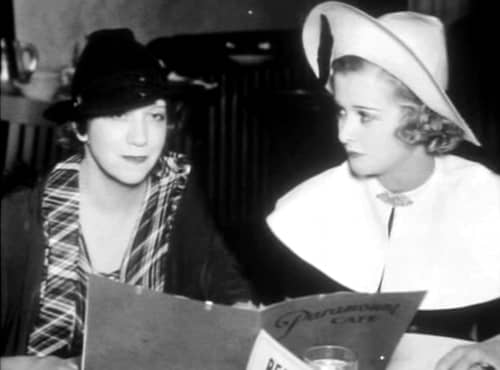
Above: Elizabeth Arden in the Paramount Cafe with an actress who appears to be Frances Farmer [1913-1970] perhaps photographed during the making of Ebb Tide (Paramount Pictures, 1937). Ebb Tide was filmed in Technicolor and used Screen and Stage make-up.

Above: 1936 Screen and Stage make-up, Looking Glass Lipstick, Face Powder and other make-up items.
See also: Arden Screen and Stage Make-up and Pan-Cake Make-up
Maine Chance: In 1933, Arden decided to convert Maine Chance into a health and beauty farm. The house and gardens were renovated, a pool was installed, new buildings and facilities were added – including guest cottages, treatment rooms, exercise rooms and recreational facilities – and it was opened for general business in 1934.
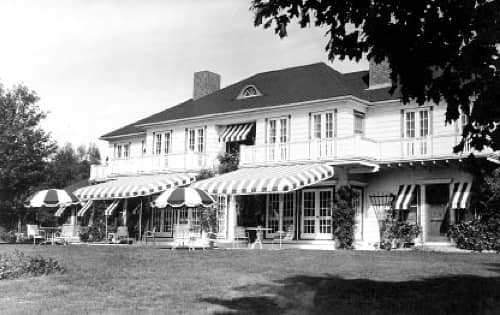
Above: Maine Chance.
Maine Chance operated between May and September each year. Guests were engaged in range of health and beauty treatments, exercise classes and outdoor activities but the emphasis was on weight control so they were kept on a strict diet originally devised by Gayelord Hauser [1895-1984].
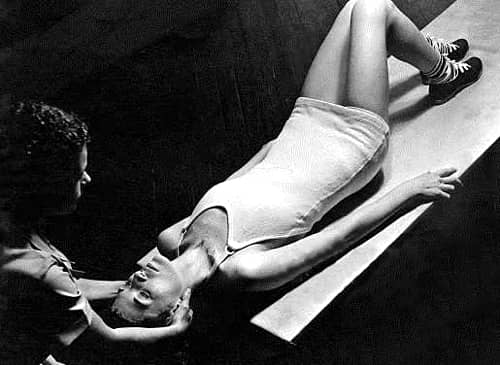
Above: 1937 A client on a tilt board at Maine Chance. The boards were developed by Ann Delafield, Arden’s director of exercise at Maine Chance. They were an anti-ageing treatment that was supposed to work by improving blood circulation to the head and neck. She took the idea with her when she left Arden to work for Richard Hudnut.
See also: Richard Hudnut
Although not a money loser, like her ventures into radio and film make-up, the large staff requirements, small guest numbers and restricted season meant that the enterprise was only barely profitable.
Eighteen to twenty guests are all that can be accommodated and it takes a staff of thirty to care for them so even at rates of $250 to $500 per week, there is little profit. But this is another of Miss Arden’s pet whims and she doesn’t care about the money.
(“Elizabeth Arden: Genius,” 1938, p. 36)
Other developments
Realising that she needed someone to help manage the wholesale side of her business after Tom Lewis departed, Arden hired Lawrence L. Schneider, then working for Condé Nast at British Vogue. Arden largely ignored his constructive advice and he soon left. A series of executives then came and went with Arden eventually resorting to poaching staff from Helena Rubinstein [1871-1965] thereby deepening the feud between the two women.
The fortunes of Elizabeth Arden in the United States mirrored the state of the economy. Lewis and Woodworth suggest that the American business was in the red to the tune of US$500,000 by 1935, forcing her to draw on her interests elsewhere to stay afloat (Lewis and Woodworth, 1973, p. 171) but things got better after that as economic conditions improved in the second half of the 1930s.
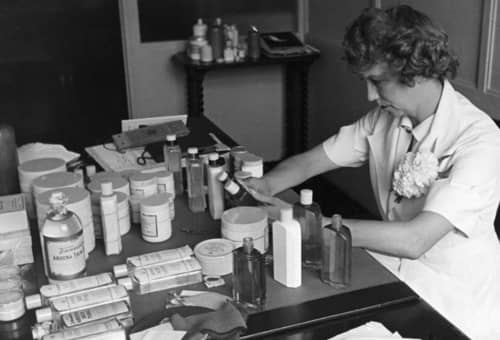
Above: 1936 Elizabeth Arden in her office reviewing product packaging.
The British arm of Elizabeth Arden did reasonable well under Edward (Teddy) Haslam’s continued sound management, allowing Arden to call on it for much needed funds. A subsidiary company, Elizabeth Arden Ltd., was established in London in 1936 and Haslam managed to persuade Arden to build a new British factory at 140 Wales Farm Road, North Acton in 1939. Designed by Wallis, Gilbert and Partners, it fortunately opened just before the war made international trade more difficult. It remained a major production centre for Arden until 2001.
Branding
In the 1930s, a new ‘Winged A’ logo began to appear on a lot of Arden packaging. The 1960 trademark registration document claimed that it was first adopted in 1934.
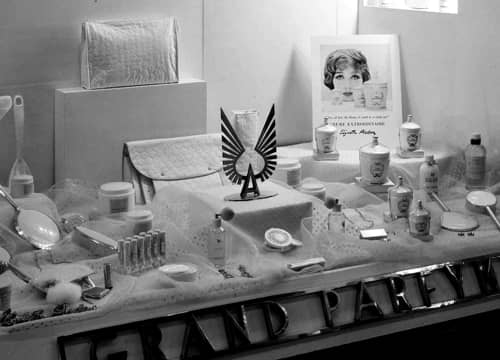
Above: 1959 Elizabeth Arden window display in the Grande Parfumeri, Oslo with a prominent Arden logo.
It is possible that the new logo was designed by the industrial designer Raymond Loewy who did some packaging work for Arden around this time.
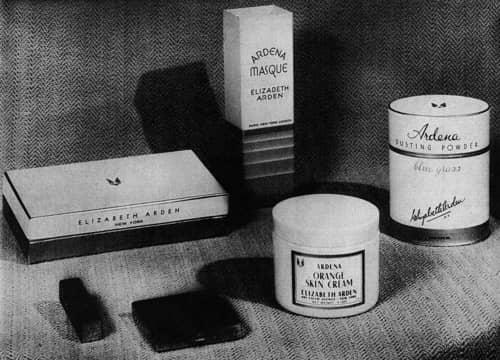
Above: 1930s Raymond Loewy [1893-1986] packaging designs for Elizabeth Arden, many with the new logo.
Perfume
When Arden’s fortunes were at a low ebb, they got a major boost from a new perfume she named Blue Grass. Introduced in in time for the Christmas of 1934, it was very popular and Arden soon added to a wide range of products scented with the fragrance including dusting powders, bath essences and soaps, all of which brought in much needed cash.
Blue Grass was advertised as inspired by the grass of Kentucky but was actually formulated by Georges Fuchs of Parfumerie Fragonard in France. It had been discovered by Arden’s sister Gladys [1884-1970] who was now well entrenched in France after her marriage to Henri Maublanc de Boisboucher [1885-1948] in 1932.
Salon treatments
Lawrence Schnieder had suggested to Arden that she close down her stand-alone salons which were becoming less profitable or losing money – a situation that also became increasingly evident at Helena Rubinstein – and concentrate more on in-store facilities (Woodhead, 2003, p. 227). However, Arden was committed to her salons and was not about to shut them down. In an attempt to increase patronage she introduced a range of new treatments some of which were aimed at the budget conscious.
Added to the existing Muscle-Strapping Skin-Toning Treatment, the Après l’Eté Treatment and the Vienna Youth Mask was the Ardena Bath (1930), Three-in-One Treatment (1932), Debutanté Treatment (1933), Ardena/Sensation Treatment (1933), Firmo-Lift Treatment (1938), and the Intra-Cellular Mask (1938). The Three-in-One, Debutanté and Ardena/Sensation Treatments show clears signs that they were introduced when things were at an economic low point.
Ardena Bath: A full-body, paraffin wax bath used as a reducing treatment. It was similar to those offered by Helena Rubinstein and others in the 1930s.
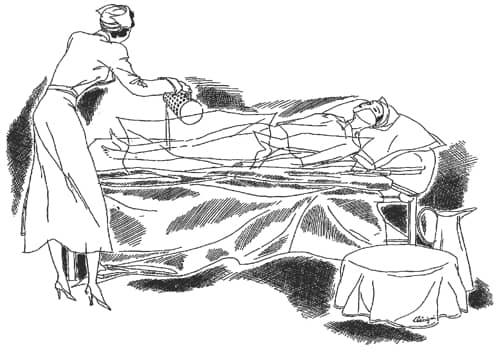
Above: 1932 Ardena Bath.
Twenty minutes of heaven in an Ardena paraffin bath, The perfect preparation for a body massage. You step into a tub lined with sheets of waxed paper. Over you they pour a warm liquid paraffin which slowly hardens until you are encased in a paraffin shell. Your face becomes pink. You are permeated in a sense of well-being. Suddenly the perspiration bursts from you, for the shell forms a vacuum which causes the pores to open and, consequently, impurities are drawn away.
(Elizabeth Arden advertisement, 1938)
See also: Paraffin Wax Treatments
Three-in-One Treatment: This facial treatment used a ‘mask’ made with equal parts of Muscle Oil, Anti-Wrinkle Cream and Pore Cream. By 1934, Arden had released this new concoction for general sale under the name Ardena Astringent Cream in a pink, opal jar. The product came with a spatula to keep the cream ‘well blended’ which suggest that the component parts separated on standing.
Debutanté Treatment: This cut-down facial, cleansed, toned and made up a client’s face in 30 minutes. It was aimed at getting economy-minded, working women into her salons during their lunch break but was also an attempt by Arden to introduce younger women to her products and salon treatments.
The Debutante Treatment is ideal for the busy woman whose time is as precious as her money. It offers a perfect means of becoming acquainted with Elizabeth Arden’s preparations and learning how to apply them at home.
(Elizabeth Arden advertisement, 1933)
Ardena/Sensation Treatment: Known under a couple of different names this facial treatment introduced a ‘new’ preparation that Arden also sold as the Ardena Sensation Cream/Salve. From all reports, the supposedly new cream was actually a version of Venetian Anti-Brown Spot Ointment first used back in 1922.
Elizabeth Arden’s new Ardena Treatment which introduces a marvellous new salve. This treatment rejuvenates and tightens the skin, re-energizes the muscles and tissues, banishes lines and wrinkles.
(Elizabeth Ardena advertisement, 1933)
Intra-Cellular Mask: Like the Vienna Youth Mask, the Intra-Cellular Mask relied on diathermy. This new treatment was therefore largely a name change brought on by the introduction of the Food, Drug and Cosmetic Act (FD&CA) and the Wheeler-Lea Amendment to the Federal Trade Commission Act in the United States in 1938. Armed with new powers the Federal Trade Commission (FTC) was unlikely to look favourably at a something with ‘Vienna’ and ‘Youth’ in its name or on the claims that it made, forcing Arden to change the name of the treatment and to scale back on its advertised benefits.
Elizabeth Arden working with a celebrated continental specialist has perfected her Intra-Cellular Mask treatment
. . . a treatment designed to tone the circulation and clear the skin through promoting the health of those underlying tissues which form the real foundation of outward beauty.(Elizabeth Ardena advertisement, 1938)
See also: The FDA, FTC and Cosmetics
Firmo-Lift Treatment: Firmo-Lift used an oil which Arden said could reduce flesh when applied with massage and friction but tighten flabby flesh when applied alone. Like the Ardena Astringent Cream and the Sensation Cream, Arden would later release Firmo-Lift as a home treatment.
Firmo-Lift is Miss Arden’s new magic, an oil of amazing properties. It reduces flesh when applied with massage and friction. It tightens flabby flesh when applied alone. If it is your face or neck, Firmo-Lift is smoothed gently on the tired or fatty spots until the oil has thoroughly seeped into the skin.
(Elizabeth Ardena advertorial, 1938)
A full-body Firmo-Lift was generally preceded by an Ardena (Wax) Bath after which the body was rubbed vigorously with a cheese-cloth soaked in lotion made from a mixture of oil and astringent. The oil was then massage in by hand and further pressed in with a roller.
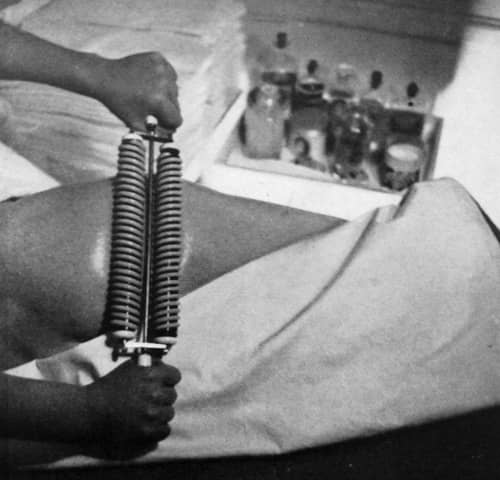
Above: 1938 Firmo-Lift treatment with the Twin-Roller. Clients could buy the roller for use at home
The treatment was completed with a brisk alcohol rub followed by a dusting with body powder.
Spot-reduction treatments on places such as the ankles also began with the Firmo-Lift Lotion applied with cheese-cloth, with one ankle soaked in a compress while the other was being massaged with Firmo-Lift Oil.

Above: 1938 Firmo-Lift spot-reduction treatment for the ankles.
Cheese-cloth bandages were also used in Firmo-Lift facials. These were usually preceded by an Intra-cellular Mask to help ‘tighten facial tissues’.
Reducing treatments
The Ardena Bath was one of a number of weight-reduction regimes available through Arden salons during this period. As well as specific body reduction treatments women could also attend exercise classes and get dietary advice from Arden instructors.
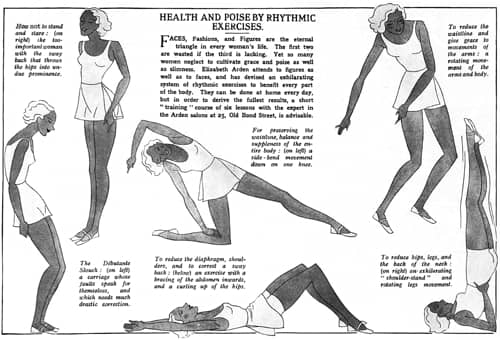
Above: 1932 Elizabeth Arden Rhythmic Exercises.
The New York salon had a wide range of weight-reduction and exercise facilities. In 1937, Arden updated these, opening the Gymnasium Moderne on the seventh floor. It was decorated with yellow walls hung with white, organdie curtains with over-drapes of white cotton, furnished with white-covered, chrome benches and alabaster Greek urns. A large painting – ‘The Miracle Flower’ ‐ by Georgia O’Keeffe [1887-1986] hung on the wall.
The facilities in the Gymnasium Moderne included ski-exercise machines and equipment for rope skipping, fencing, badminton and deck tennis, along with the spaces for exercise classes that helped clients with weight control, flexibility, posture and poise. In 1938, Arden added dancing classes for tap tango, rumba and the waltz.
From about 1930, women could also undergo sessions in the Giant Roller to reduce the size of their hips and thighs and buy an Ardena Twin Roller to use at home.
By 1934, clients could book in for an Electro-Reducer Treatment, an electrical device used for spot reduction. The precise action of this machine is unknown to me but, in the 1940s, Arden was using electrical machines to ‘passively exercise’ muscles with electrical impulses, so it is possible that the Electro-Reducer worked in the same way.
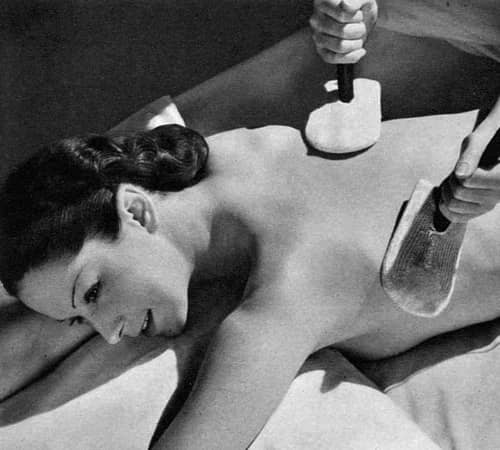
Above: 1936 Electro-Reducer as used in the London salon.
From 1938, the previously mentioned Firmo-Lift Treatment was also used in spot reduction in areas such as the ankles. At home, clients could use their astringent patter charged with Slenderlines Reducing Lotion (1935) – known as Streamline Reducing Lotion in Britain – to pat away fatty deposits.
Slenderlines/Streamline Reducing Lotion: “Plump ankles . . . a double chin . . . a dowager’s hump . . . they’re no cause for alarm . . . or strenuous reducing methods either. Just pat and persevere with Elizabeth Arden’s amazing Slenderiines Reducine Lotion and the Ardena Astringent Patter . . . and all your troubles will vanish, literally, into thin air!”
Hair styling
One of Lawrence Schneider’s suggestion to Arden in his brief time with the firm was to expand the hair dressing and hair styling services In her salons. Hair styling facilities were installed in the Fifth Avenue salon in 1936 under the direction of Monsieur Leonard and Arden then rolled out hairdressing services in number of her salons across the United States.
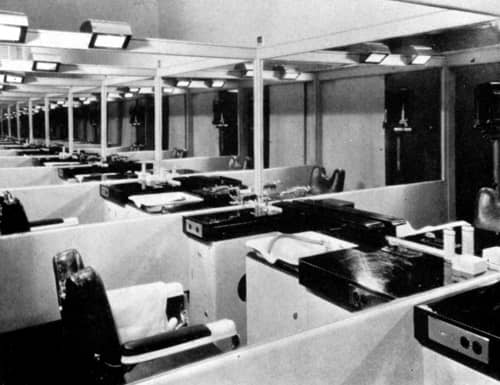
Above: 1939 Hairdressing booth as viewed in a multiple reflecting mirror in the Chicago salon at 70 West Walton Place.
On the recommendation of her sister Gladys, Arden hired the French hair-stylist Guillaume Guglielmi to promote these new facilities and create hair styles specifically for them. In the years leading up to the outbreak of the Second World War, Guillaume did annual promotional tours for Elizabeth Arden across the United States.
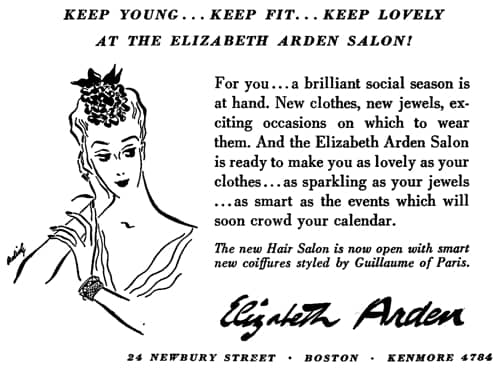
Above: 1938 Elizabeth Arden Boston announcing a new hairdressing salon with coiffures by Guillaume of Paris.
Skin-care
Arden spent more time developing her make-up than her skin-care range in the 1930s so the Arden skin-care home treatments changed very little during the decade. All began with Cleansing Cream and Arden Skin Tonic.
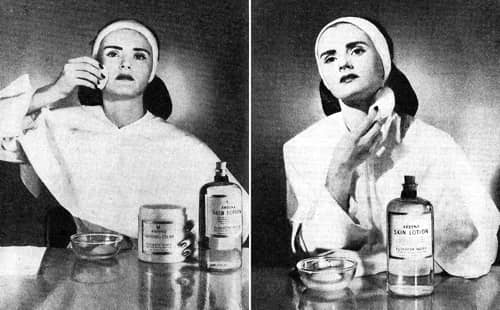
Above: Cleanse with Ardena Skin Lotion and Ardena Cleansing Cream and then refresh with Ardena Skin Lotion.
Cleansing was followed with Orange Skin Food, if you had a dry skin or a thin face, or Velva Cream if the face was sensitive or full.
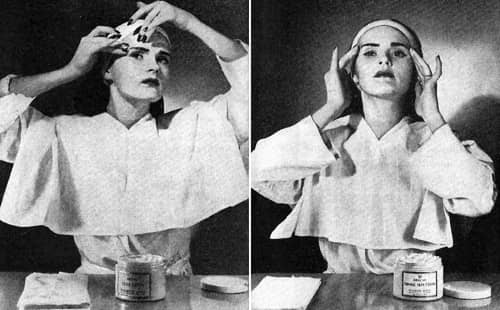
Above: Smooth with Ardena Velva Cream (normal or young skin) or Ardena Orange Skin Food (dry of older skin).
Enlarged pores were still treated with Pore Cream, wrinkles with Muscle Oil.
Also see the company booklet: Elizabeth Arden’s little book of instructions (c.1932)
In 1933, a minor modification to the home-care routine occurred when Arden introduced the Ardena Cream Patter. Arden had long recommended that her clients use her Venetian Ardena Patter to pat in skin tonics and astringents. This was supposed to stimulate blood circulation and reduce the possibility of stretching the skin. This new patter was to do the same thing for Arden’s skin creams and, after it was introduced, the older one was usually known as the Ardena Astringent Patter.
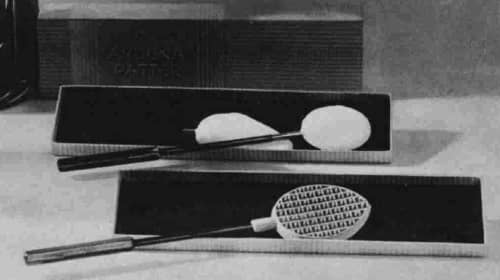
Above: 1934 Ardena Astringent Patter (rear) and Ardena Cream Patter (front) with a rubber head.
Ten minutes of rhythmical patting each day with this new patter will do marvels for wrinkles and furrows! . . . its flexibility and perfect rhythm give a firm, even count that stimulates drooping muscles and increases the nourishing effect of the creams you use.
(Elizabeth Arden advertisement, 1933)
In 1937, Arden modified this routine once more when she introduced her Face-Moulding Home Treatment and added yet another device, the Ardena Face Moulder, in 1938.
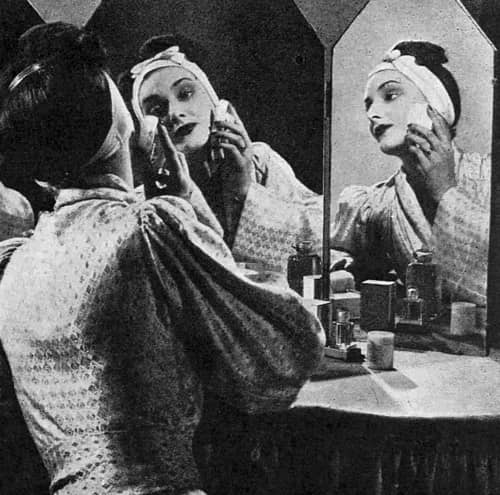
Above: 1938 Woman using an Ardena Face Moulder.
After cleansing, toning and nourishing the face, the Ardena Face Moulder, saturated with Special Astringent Lotion, was worked over the face in much the same way as the Ardena Astringent Patter except that the astringent was pressed in not patted. Women were also expected to undergo a set of facial exercises to further ‘strengthen’ the facial muscles, a very old idea that went back to the beginning of the twentieth century at least.
The Face-Moulding Home Treatment is not complicated. It is simply an amplification of Miss Arden’s well-known Cleanse, Tone, and Nourish routine—plus a gentle Muscle Strapping Treatment with her new Face Moulder, followed by her Facial Exercises. The Moulder which does not stretch the skin, even on the delicate nerve centres around the eyes—has been devised to do the same work for you at home that the deft finger-tips of a Salon assistant accomplish when you have an Elizabeth Arden Treatment. It is especially effective for the contour and throat.
(Elizabeth Arden advertisement, 1938)
See also: Facial Gymnastics
Sales of the Face Moulder appear to have been slow and after stocks were depleted during the Second World War it was quietly shelved. However, Arden did not abandon the idea behind face moulding and resurrected it when she released her Firmo-Lift Treatment Lotion in 1951.
See also: Face Moulding
Another variation in the basic home treatment routine occurred in 1938, when Arden moved away from using a single cleanser and added Ardena Fluffy Cleansing Cream for dry or sensitive skin.
Fluffy Cleansing Cream: “[A] special cream particularly suitable when the skin is in a very dry and sensitive condition or blotchy and eruptive. It is also excellent for a quick cleanse during the day before renewing make-up when the skin is dry. Apply with the finger-tips.”
Used faithfully by lovely, well-groomed women all over the world . . . these are the basic steps towards “The Elizabeth Arden Look.” Ardena Cleansing Cream or Fluffy Cleansing Cream—because thorough cleansing is so vital to healthy, beautiful skin . . . Ardena Skin Lotion to freshen . . . Velva Cream to soothe and soften . . . or Orange Skin Cream if your skin tends toward dryness.
(Elizabeth Arden advertisement, 1939)
In keeping with her heightened interest in make-up, Arden also developed Liquid Cleanser for removing make-up during the day or when travelling. It was applied with a pad of cotton wool squeezed out with cold water.
Other developments
Other skin-care products added during this period that are worth noting are: Eight Hour Cream (1930), Joie de Vivre Gland Cream (1934), Velva Cream Mask (1935), and Ardena Special Neck Cream (1942).
Eight Hour Cream
Eight Hour Cream was developed to soothe skin irritated by external causes but particularly after to exposure to the sun or wind. Arden also recommended it for chapped lips, dry scalp and even in place of Brilliantine for very dry hair.
The product was an ointment rather than a cream, translucent orange in colour, made mostly of petrolatum. Later advertising described it as ‘highly medicated’, a reference to its use of salicylic acid, a known keratolytic.
Eight Hour Cream: “A highly medicated salve which brings rapid relief to rashes, cold sores, open eruptions and burns. It is also effective in bad cases of sunburn. Eight-Hour Cream is so named because it acts so quickly.”
When first introduced, Arden gave it little attention but the product became very popular – perhaps helped by the stories that Arden used it on her horses – and is still sold by the company today.
Gland Cream
Helena Rubinstein had introduced her Hormone Twin Youthifiers in 1931. In 1934, Arden followed with her Gland Cream – also known as Joie de Vivre (Famous Gland Cream) – using material imported from Europe.
Joie de Vivre Gland Cream: “[H]as properties that are both restorative and recreative. Absorbed through the skin, they will stimulate lifeless tissue, so that it once again assumes the vitality of youth – preventing wrinkles correcting them if they have already developed.”
The active ingredient in the Gland Cream is unknown to me but it may have been a glandular secretion rather than oestrogen, a situation that probably applied to Rubinstein’s Hormone Twin Youtifiers as well. Arden persisted with it until it was replaced by Ardena Special Hormone Cream in 1951.
See also: Hormone Creams, Oils and Serums
Velva Cream Mask
Arden’s first mask, the Venetian Ardena Masque, had been introduced back in the early 1920s. This second mask seemed to do much the same thing. After cleansing and toning the skin, the mask was applied and left for 10-15 minutes to dry while the face was kept perfectly still.
Ardena Velva Cream Mask: “[A] quick stimulant before a hurried toilet. Applied for 15 minutes it tightens muscles, awakens circulation, smoothes and relaxes the skin.”
Arden suggested using the fingers to stretch the skin slightly while the mask set which would have increased the ‘lifting and tightening’ feeling generated by the drying mask.

Above: Velva Cream Mask. The model has her elbows on the table and is lifting her face slightly while the mask sets using her thumbs under the jaw bone and her index fingers at the corners of the eyes.
Ardena Special Neck Cream
Arden’s obsession with oils and astringents continued with Ardena Special Neck Cream. Introduced into the United States just before America entered the Second World War, it lifted and firmed the throat. Arden recommended that it be smoothed into the hollows of the throat 2-3 times a week and left on overnight.
Special Neck Cream: “[T]o help relieve a crepy wrinkled throat. Rich in oils with an astringent action.”
Also see the company booklet: Foundations of beauty: A little book of instructions (c.1939)
Regulation
Like other cosmetic companies, Elizabeth Arden was subjected to increasing regulation in the United States as the government there moved towards the passing of the previously mentioned legislation in 1938. Much to her annoyance Arden began to receive cease and desist notices from the Federal Trade Commission (FTC) concerning the claims for many of her skin-care products including Ardena Velva Cream Mask, Eight Hour Cream, Venetian Orange Skin Cream and Ardena Orange Skin Cream.
Elizabeth Arden Sales Corp., a corporation, Elizabeth Arden, Inc., a corporation, and Florence M. Lewis, an individual operating under the trade name of Elizabeth Arden, vendor-advertisers, were engaged in selling cosmetics designated Ardena Velva Cream Mask, Eight Hour Cream, Venetian Orange Skin Cream and Ardena Orange Skin Cream and agreed in soliciting the sale of and selling said products in interstate commerce to cease and desist from representing directly or otherwise:
(a) That respondents’ preparations, either alone or In combination with one another, will remove or prevent lines or wrinkles, or have any effect upon such conditions other than temporarily softening the appearance thereof;
(b) That any of respondents’ products “lifts muscles” or has any other effect upon the muscles;
(c) That respondents’ products will affect the contours in any way, or will refine the pores;
(d) That respondents’ Eight-Hour Cream is a competent treatment or an effective remedy for pimples, rashes, cold sores, and eruptions, or that this product keeps the scalp healthy;
(e) That any of respondents’ products furnish nourishment to the skin or are rich in Ingredients necessary to thin faces, or are recommended for skins lacking natural nutritive qualities;
(f) That the application of respondents’ products can assure a young skin.
The respondents further agreed not to publish or cause to be published any testimonial containing any representation contrary to the foregoing agreement.(‘Federal Trade Commission decisions’, 1940, p. 1670)
This forced her into making a number of product name changes; e.g., Pore Cream and Muscle Oil became Porine Cream and Moisture Oil respectively. It also required her to tone down the claims for many of her skin-care products and treatments in the United States.
Sun preparations
Suntanning was firmly entrenched by the 1930s and Arden made a wide range of products for women to use on the beach. Some of these could be used either as a skin-care cosmetic or as make-up.
Arden’s earlier Ardena Protecta Cream (1928) was still being sold and had its shade range extended through the decade. By 1937, it came in White, Naturelle, Rachel, Rose Rachel, Rosetta-Bronze, and Sun Beige shades.
!n 1933, Arden released Ardena Sun-Pruf Cream in tubes and Ideal Suntan Oil in kidney-shaped bottles in costume-colored waterproof cases; both designed for the beach.
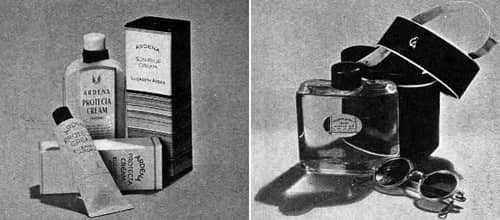
Above: 1939 Ardena Protecta Cream in bottles and tubes and Sunpruf Cream in tubes (left), and Ideal Suntan Oil (right).
Ardena Sun-Pruf Cream: “Its special qualities make it possible to be completely tan-proof, or to brown the shade that fits in with your summer color scheme. It prevents blistering . . . deflecting the harmful, short rays, while the good, health-giving rays pass through it unobstructed! It also guards against freckling and is cool and pleasant to the skin.”
Ideal Suntan Oil: “Promotes tan but prevents sunburn and keeps the akin from getting dry and flaky.” Shades: Honey, and Café.
Women who wanted a tanned look without resorting to sunbathing could use Velva Beauty Film also packed in a convenient tube.
Velva Beauty Film: “[A] perfect ready-made tan (Indispensable with Shorts) covers blemishes, gives legs exquisite finish.” Shades: Light, Dark, and Evening. Also Suntan (1934).
The product would go on to become Velva Leg Film (1941), used as a cosmetic stocking substitute during the Second World War.
See also: Cosmetic Stockings
For sun protection on the ski slopes there was Ski-Sports Geleé (1939), a colourless, non-sticky, gel substance that did not freeze in cold weather also packed in a tube.
In 1940, Arden added Liquid Bronze-Glo, a make-up in the same shades as the Ideal Suntan Oil. This superseded the earlier Bronze Liquid Lotion, and, like the earlier bronzer, it was applied with a pad of dry cotton wool, then blended in with the fingertips. A deeper colour could be obtained by adding a second coat after the first had dried.
Liquid Bronze-Glo: “To stimulate a head-turning tan on face, arms and legs.” Shades: Honey, and Café.
Also see the company brochure: To tan or not to tan? (c.1936)
Depilatories
Before applying an artificial tan on their legs women generally removed their leg hair. Arden had two depilatories on her books, Venetian Electra (Wax) Eradicator, and Venetian Dermatex Depilatory, a powder made with calcium sulphide that required mixing before use. In 1940, she added Sleek, a cream depilatory sold in a tube.
Sleek: “[A] summer necessity for satin-smooth legs. This white, fragrant cream quickly removes unwanted hair.”
Make-up
In the 1920s, Arden had organised her make-up shades according to complexion, hair and eye colour but, in 1931, she began pushing a different idea, selecting make-up according to clothing colours. She would develop this concept through the rest of the decade boldly declaring that “any woman can wear any colour”.
“Any Woman Can Wear Any Colour” Says Elizabeth Arden!
This is not a theory, but a proven statement. You must select your make-up as you would your accessories . . . to harmonize and complement the colour of the frock you wear.(Elizabeth Arden, c.1936, p.34)
In 1931, Arden introduced Colour Scheme Wheels to help clients coordinate their make-up with their clothes. These could be rotated to show the Arden make-up shades best suited to a particular dress colour. The first version was square but later models were circular.
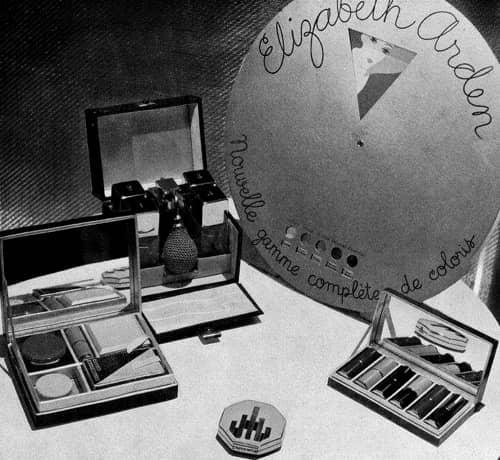
Above: 1932 A large colour wheel used as a store display in France. Smaller versions were available for clients to take home. The other objects are: Colour Harmony Box (left), coffret of perfumes (back), Arden Lipstick Ensemble (right) and Ardenette Compact (front).
Your Color Scheme Complete
ELIZABETH ARDEN has devised this clever chart to show you, through the use of exactly the right make-up, how to co-ordinate your coloring and your costumes. When you turn the disk at the right to the shade of your frock, the harmonizing tints of powder, rouge, lipstick, eye shadow and cosmetique that should be worn with the shade are shown at the bottom of the chart in full color.(Elizabeth Arden advertisement, 1931)
Then, in 1932, Arden introduced Colour Harmony Boxes; eight different combinations of lipstick, rouge, eye shadow and mascara to harmonise with different costume colours.
You ask to see the Elizabeth Arden Color Harmony Box whose make-up preparations coordinate with the color of your dress. Then, if it is a rhapsody in blue you are wearing, you purchase the Color Harmony Box for Blue, containing American Beauty Rouge, Lysetta Poudre d’lllusion, Viola Lipstick, Black Cosmetique and Bleu Ciel Eye Sha-do. If your gown is red, you find a Color Harmony Box with exactly the correct make-up combination. So you change your color by means of these make-up preparations … and not the dress.
(Elizabeth Arden advertisement, 1932)
Arden also began publishing annual Colour Charts which listed the perfect Arden shade of lipstick rouge, powder, eyeshadow and mascara to wear with current fashion colours predicted by organisations such as the Textile Color Card Association.
In 1936, Arden added Color Capes. Produced in current fashion colours the capes were placed over the shoulders, so that demonstrators could show clients how the matching make-up looked.
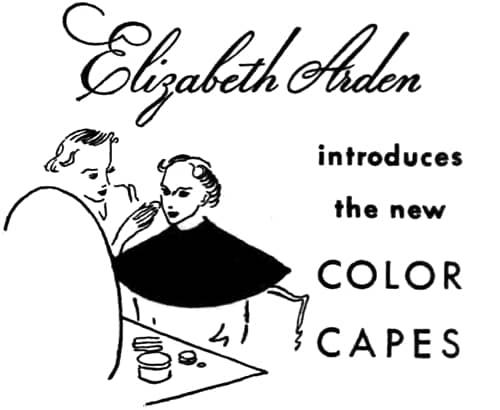
Above: 1936 Elizabeth Arden Color Capes.
If you think you “can’t wear” the new colors you’ll miss half the excitement. So Elizabeth Arden has originated these Color Capes, each one matched exactly to an important costume color, and she has worked out special make-ups for every shade. Slip one around your shoulders.
Then while the color reflects on your face, let our Elizabeth Arden representative suggest to you the right make-up. (The Color Harmony Chart has this all down so you won’t forget).(Elizabeth Arden advertisement, 1936)
Also see the booklet: The Quest of the Beautiful (c.1937)
Face powders
By 1932, Arden had rationalised her range of face powders and organised them into two main groups. In North America these were Illusion Powder (Poudre d’Illusion) and Venetian Flower Powder. In Britain and Europe, Illusion Powder was known as Ardena Powder (Poudre Ardena).
Illusion/Ardena shades included Ardena/Illusion, Rachel, Mat Foncé, Ocre, White, Minerva, Banana, Poudre de Lilas, Amande Verte, Light Rosetta, Dark Rosetta, Rose Rachel and Lysetta while Venetian Flower Powder tints came in White, Cream, Maréchal Neil, Naturelle, Rose, Special Rachel, Spanish Rachel, and Spanish Coquette. Most of these shades were available in the 1920s, the exceptions being Rose Rachel and Spanish Coquette which were released in 1932.

Above: c.1935 Ardena and Flower Powder shades. Ardena Powder Shades: Ardena, Rachel, Foncé, Rose Rachel, Mat Foncé, Banana, Light-Rosetta-Bronze, Dark Rosetta-Bronze, Minerva, Ocre, Lysetta, Lilas, and Verte Ardena. Also in White. Flower Powder Shades: Cream, Rose, Naturelle, Special Rachel, Spanish Rachel, Spanish Coquette, Poudre Amourette, and Poudre de Soir. Also in White.
Venetian Flower Powder appears to have disappeared by the end of the decade after Arden introduced a new powder in 1935 in a pink and gold box. The new powder went under various names – Camee in France, Cameo in the United States and Japonica in Britain and Australia.
Cameo/Japonica Powder: “A new gossamer-sheen powder, made from an exclusive Paris formula. It clings delicately for hours, and is notable for its lovely porcelain-smooth finish.” Shades: Ivoire, Naturelle, Mat Foncé, Special Mat Foncé, Dark Rachel, Rose Rachel, Banana, Light-Rosetta-Bronze, Dark Rosetta-Bronze, Spanish Rosetta-Bronze, Lysetta, and Lilas.
When used alone it was suited to oily skin but it could be combined with Ardena/Illusion Powder using a two-powder technique Arden called the ‘New Complexion’. This superimposed Cameo/Japonica Powder over Illusion/Ardena Powder.
ELIZABETH ARDEN has created a new vogue achieved with two shades of powder—your favourite tint in Ardena smoothed over with just the right shade of Japonica powder, a brand new finishing powder just created by Miss Arden. It is notable for its definitely new, porcelain finish texture that gives a cameo smoothness to the skin. Gossamer sheer, yet with a unique quality of impermeability the delicate bloom of Japonica powder clings all day long.
(Elizabeth Arden advertisement, 1935)
An example of the technique can be seen with the Copper and Chinese Amber shades introduced in 1936. A Chinese make-up was achieved by powdering Chinese Amber Cameo/Japonica Powder over Chinese Ardena/Illusion Powder, while a Copper make-up used Copper Cameo/Japonica over Copper Ardena/Illusion Powder.
Also see the company booklet: Why two powders are better than one (c.1944)
To help women follow up on this idea Arden introduced Complexion Boxes (1936) containing complementary shades of Ardena/Illusion and Cameo/Japonica of Powder along with a blending brush.
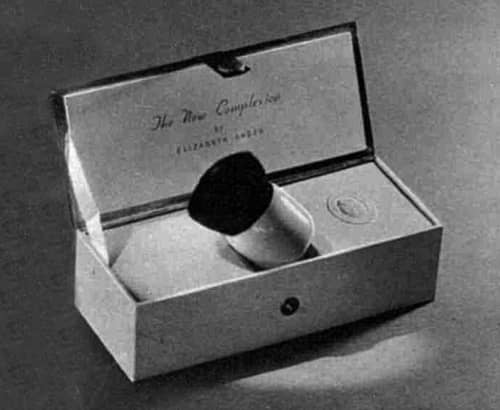
Above: 1936 Elizabeth Arden.
Other shades of Ardena/Illusion and/or Cameo/Japonica Powder added through to 1944 included: Sun Fair (1938); Renoir Pink, Goya Yellow, and Light Lysetta (1940); Rose Beige (1941); and Paradise Pink (1944), the last shade only coming in Cameo/Japonica Powder.
Arden would later extend this idea of combining two shades to lipstick and eye shadow.
Foundations
By 1930, Arden had an extensive range of foundations including: Amoretta Cream, made with a vanishing cream base for normal skin types; Ultra-Amoretta Cream, a heavier cream for dry skins; Crème de France, a soothing day cream for sensitive skins; Lille Lotion, a liquid powder for oily skin types; and Protecta Cream, for outside activities such a sports. They all came in at least two shades with Lille Lotion being the most extensive, coming in White, Cream, Naturelle, Rose Rachel, Special Rachel, Spanish Rachel, Ocre, Light Rosetta-Bronze, and Dark Rosetta-Bronze.
In 1936, Arden combined Crème de France and Lille Lotion to create a new foundation she called Lille de France. This was something she had previously recommended, so this new foundation was a formalisation of a longstanding practice. It was recommended for all skin types but also, on occasion, just for dry skin.
Lille de France: “[R]ecommended for use on every type of skin . . . As a powder foundation it has no rivals. Smooth and flattering itself, it will enhance the perfection of your make-up.” Shades: White, Cream, Naturelle, Special Rachel, Spanish Rachel, Ocre, Light Rosetta-Bronze, and Dark Rosetta Bronze. Also Sun-Beige (1937).
Two additional foundations aimed at younger complexions were added towards the end of the decade – All-Day Foundation Cream (1939), a heavier foundation to help conceal blemishes, and a lighter Feather-Light Foundation Cream (1940) for a less obvious make-up. Both foundations came in a limited range of shades.
All-Day Foundation Cream: “Glows softly through powder and gives your face a lovely, luminous look. Helps conceal sudden blemishes – freckles – tan.” Shades: Natural, Rachel, Rose-Rachel, and Rosetta Bronze. Dark Rachel and Telecast Blonde added in 1940.
Feather-Light Foundation Cream: “[L]ighter weight foundation cream that keeps your powder fresh and smooth.” Shades: Naturelle, Rachel, and Rose Rachel.
Also see the company brochure: Art in cosmetics (c.1936)
Lipsticks and rouge
Arden continued to sell her Indelible Lip Paste in Light and Dark shades during the 1930s but lipsticks maintained their pre-eminence and grew in importance.
In 1931, to help women coordinate their make-up with current fashion colours, Arden introduced the Arden Lipstick Ensemble, a boxed set of six indelible shades each in a case of a different colour.

Above: 1931 Arden Lipstick Ensemble. The lipsticks could also be bought separately. Shades: Chariot (lacquer red case), Printemps (fern green case), Victoire (all black case), Coquette (black case with oyster white top), Viola (blue case), and Carmenita (black case with silver top). Individual lipsticks could also be bought separately.
Be gay . . . or demure. Be dashing . . . or subdued. Be sophisticated . . . or naive. The new Arden Lipstick Ensemble endows you with the power to change your personality to suit your mood. It enables you to wear the new colors successfully. Six lovely lipsticks in six enchanting shades. Petal-smooth . . . really indelible . . . easy to apply . . . exquisitely tinted.
(Arden advertisement, 1931)
In 1934, Arden added an automatic lipstick along with a new compact. Automatic lipsticks could be opened with one hand and a number of companies introduced them in the 1930s, so Arden was following a trend. Helena Rubinstein first sold one back in 1931 and added a second in 1935.
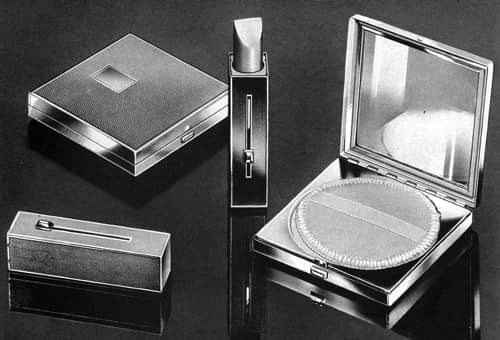
Above: 1934 Elizabeth Arden Jewelled Compact and Automatic Lipstick.
Automatic Lipstick: “Now you need but one hand to operate your favorite Elizabeth Arden lipstick. It opens and closes with a flip of the finger. A lovely automatic holder in dull gold . . . with a jeweled slide . . . garnet, sapphire and emerald.” Shades: Chariot, Printemps, Victolre, Coquette, Mat Victoire, Viola, Redhead and Carmenita.
See also: Lipsticks
Another novel case introduced by Arden during this period was the Looking-Glass lipstick (1936). This was also an automatic but it came encased in lid that opened up to reveal a small mirror.
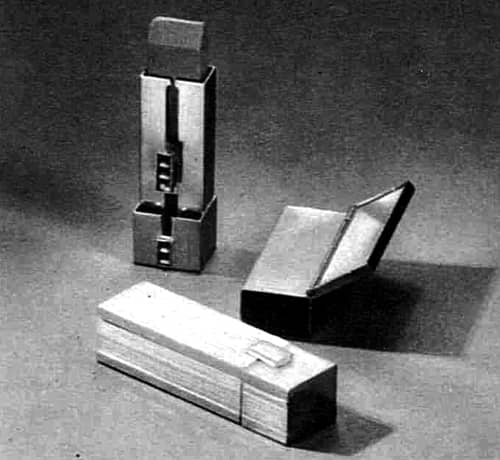
Above: 1936 Elizabeth Arden Looking-Glass Lipstick. Lipstick (top), mirror (right) and enclosed case (bottom).
During the decade, Arden added new shades of lipstick as fashion colours came and went. Those that I know of up to 1945 are: Chariot, Printemps, Victoire, Coquette, Viola, Carmenita, and Flame (1931); Mat Victoire (1933); Redhead (1934); Light Nasturtium, Dark Nasturtium, and Tweeds (1935); Copper (1936); Redwood, and Royal (1937); Day Cyclamen, Night Cyclamen, and Prince’s Feather (1938); Burnt Sugar, Stop Red, Sky Blue Pink, and It’s You (1939); Ruby, Sapphire, Amethyst, Primula, Blush Rose, Cinnabar, Schoolhouse Red, Telecast Red, Candy Cane, and Rose Fumée (1940); Magenta, and Victory Red (1941); Red Feather, and Blithe Spirit (1942); Mille Fleurs, Rose Natural, and Montezuma Red (1943); Crimson Lilac, Paradise Pink, Radiant Peony, and Evening Cyclamen (1944); and Winged Victory (1945).
Arden continued to produce liquid, cream and compact rouges right through the 1930s. These generally complemented her lipsticks and the two forms of make-up were often, but not always, given the same shade name. The liquid Ardena Rose Color Rouge now also came in a Geranium shade and other shades were added to the Amoretta Cream Rouge, Ardena Cream Rouge and the Dry Rouge as fashions changed, with the Ardena Cream Rouge having the widest range of tints.
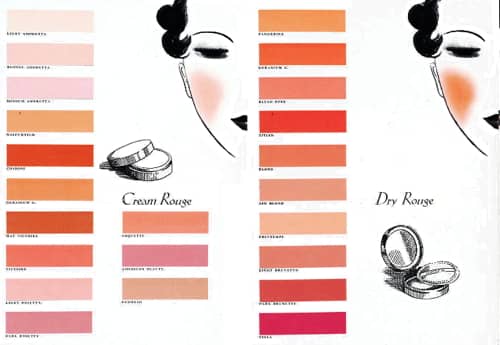
Above: c.1935 Elizabeth Arden Cream and Dry Rouge shades. Cream Rouge shades: Light Amoretta, Blonde Amoretta, Medium Amoretta, Nasturtium, Chariot, Geranium G., Mat Victoire, Victoire, Light Rosetta, Dark Rosetta, Coquette, American Beauty, and Redhead. Dry Rouge shades: Tangerine, Geranium G., Blush Rose, Titian, Blond, Ash Blond, Printemps, Light Brunette, Dark Brunette, and Viola.
Eye make-up
Elizabeth Arden had a complete line of eye make-up in her inventory in 1930 which included: Venetian Eyelash Cosmetique, a cake mascara; Arden Liquid Cosmetique, a liquid mascara; Venetian Eyebrow Pencil; and Venetian Eye Sha-Do, a compact eyeshadow.
By 1931, Arden had added Eye Sha-Do Paste in a wider range of shades and then, through the decade, added additional colours as fashions changed.
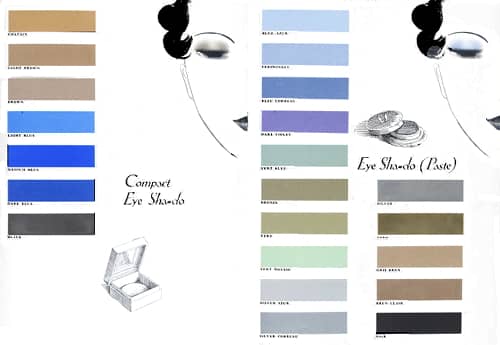
Above: c.1935 Elizabeth Arden Eye-Sha-Do Paste and Compact shades. Eye Shado Paste shades: Blue Aqua, Periwinkle, Blue Corbeau, Dark Violet, Vert Bleu, Bronze, Vert, Vert Mousse, Silver Arum, Silver Corbeau, Silver, Gris Brun, Brun Clair, and Noir. Eye Shado Compact shades: Chatain, Light Brown, Brown, Light Blue, Medium Blue, Dark Blue, and Black.
Arden also extended the shade range of her Eyelash Cosmetique. By 1935, it came in Violet, Light Blue, Dark Blue, Black, Dark Brown, Brown and Green shades with Copper added later.
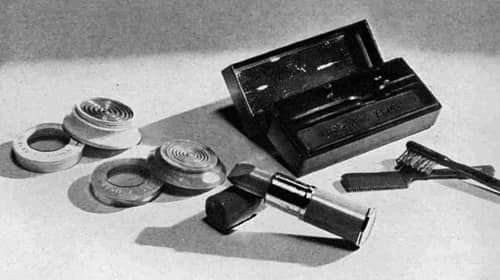
Above: 1939 Elizabeth Arden Eye Sha-Do, Lipstick and Water Cosmetique with brush.
One ‘new’ product added during this period was Ardena Stimulash. In 1936, Arden had received a cease and desist notice from the FTC about Venetian Eyelash Grower. Venetian Eyelash Grower was renamed or replaced with Ardena Stimulash in 1938 and, although the name suggests it, Arden stopped making claims that it “encouraged the growth of long thick lashes”.
Ardena Stimulash: “[A] black cream to enhance the beauty of the eyebrows and lashes that can be applied with or without mascara.”
Nail cosmetics
Arden had sold a nail polish in the 1920s but it only came in a delicate, pink, translucent shade designed to produce a ‘natural-looking’ nail. By 1934, Arden had begun to rectify this situation adding a number of shades to match the Ensemble Lipsticks she had introduced in 1931. It seems likely that her polishes were now incorporating pigments to create more modern-looking, opaque, cream polishes, a trend that became firmly established in the 1930s. In the second half of the 1930s Arden also began matching her lipsticks and nail polish, another fashion trend that became entrenched during the decade.
See also: Nail Polishes/Enamels
Arden added additional nail polish shades to coordinate with her new lipstick colours as these came on the market. Those that I have identified are: Chariot, Printemps, Victoire, Nasturtium, Sunset, and Sunrise (1934); Redwood (1937); Cyclamen, Copper Rose, and Prince’s Feather (1938); Stop Red, Sky Blue Pink, Burnt Sugar, and It’s You (1939); Ruby, Sapphire, Amethyst, Primula, Blush Rose, Cinnabar, Schoolhouse Red, Telecast Red, Candy Cane, and Rose Fumée (1940); Magenta and Victory Red (1941); Red Feather, Blithe Spirit, and Blackout (1942); Montezuma Red (1943); Crimson Lilac, Paradise Pink, and Radiant Peony (1944); and Winged Victory (1945).
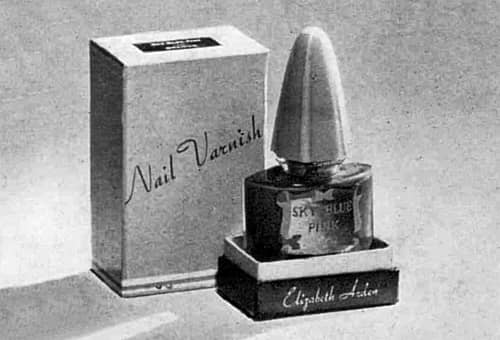
Above: 1939 Elizabeth Arden Nail Varnish.
Like most other cosmetic companies, sales of Arden nail polishes lagged well behind the specialist nail polish producers, such as Cutex, Peggy Sage and Revlon.Arden reformulated her nail polishes in 1940, reduced their price and even included a matching miniature lipstick for a while but this had little impact on companies like Revlon.
There’s new formula which makes them more beautiful, more highly resistant to chipping and crocking.
There’s a new price—75c
There’s a Matching Miniature Lipstick included, for a limited time, so that you may match your tips and fingertips the Elizabeth Arden way.(Elizabeth Arden advertisement, 1940)
Revlon would become an increasing problem for Elizabeth Arden and other long-standing, salon-based companies as it expanded its operations first into other forms of make-up, then into skin-care and finally into most segments of the beauty industry.
See also: Revlon
In addition to improving and extending her nail polish range, Arden added a number of auxiliary products starting with Nail-O-Tonik Oil and Nail-O-Tonik Oil Enamel Polish in 1935.
Nail-O-Tonik Oil: ‘[A] rich, penetrating oil which gives added life and beauty to both the nails and the cuticle. It prevents broken, split, brittle nails . . . softens rough, ragged cuticle . . . and eliminates painful, unsightly hangnails.”
Nail-O-Tonik Oil Enamel Polish: “[I]mparts an exquisitely brilliant, long-lasting luster to the nails . . . at the same time strengthening their health and beauty. It is made on an ultra-rich oil base, and Is unparalleled for nourishing the nails. This delicately cloud-pink, creamy paste should be used both before and after applying liquid polish.”
The Nail-O-Tonik Oil Enamel Polish was quickly replaced with Nail Protecto in 1936, the same year that she added Hand-O-Tonik, a new hand lotion.
Nail Protecto: “[A] creamy liquid which serves as a protective foundation for your nails, helping to prevent their becoming brittle or broken. Apply it before you put on your polish.”
Hand-O-Tonik: “ [A] marvellous recipe against redness and roughness.”
Colour coordination
The addition of a satisfactory nail polish with a range of shades enabled Arden to offer make-up ranges that colour coordinated lipstick, rouge, eye shadow and nail polish with each other and with current fashion shades.
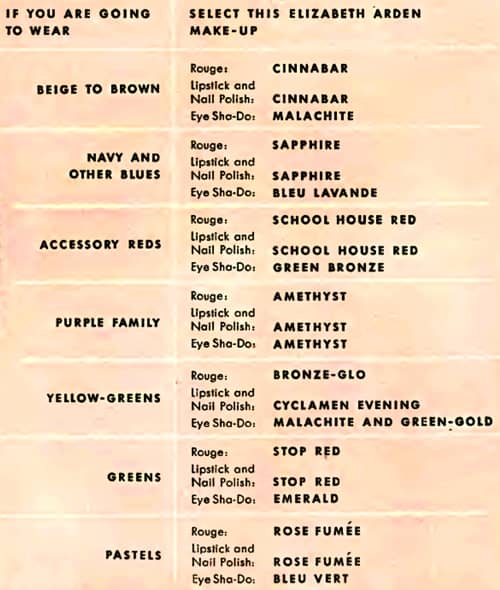
Above: 1941 Elizabeth Arden make-up chart coordinated with fashion colours.
It also allowed Arden more scope to do the type of large colour promotions that Revlon became increasingly known for in the 1940s and 1950s after it added lipsticks (1939) and rouge (1940) to its nail enamel lines.
Wartime
In 1939, Arden moved the Paris salon to the Place Vendôme. She attended the opening but had returned home before war broke out in September, 1939.
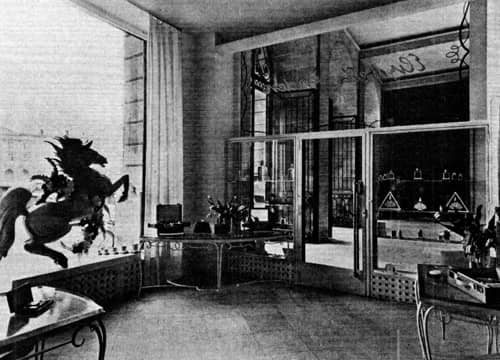
Above: 1939 The new Paris salon in the Place Vendôme with a large, blue, ceramic horse – a commonly used motif in Blue Grass advertising – in the window.
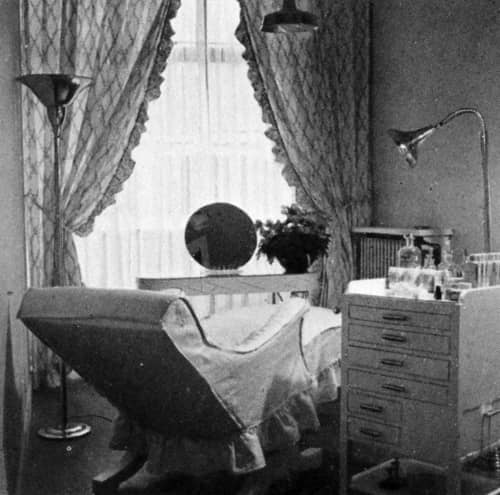
Above: 1939 Treatment room in the Paris salon.
Arden begged her sister Gladys to leave Europe but Gladys refused. Gladys’s husband was very right wing and Arden hoped this would shield her sister from the Germans after they occupied Paris in June, 1940. Gladys was eventually arrested and interned in February, 1944 but her husband managed to get her moved from Ravensbrück Concentration Camp in Germany to an internment camp in Vittel, France and she was released late in 1944. In London, Arden was also lucky. The Bond Street salon and the company offices in Grosvenor Street escaped the Blitz.
In the United States, Arden’s war efforts consisted of fundraising for organisations like the Red Ross, setting up powder rooms in Service Women’s Centers sponsored by Kappa Kappa Gamma, and, in 1944, the creation of Montezuma Red make-up for the new Women’s Reserve of the United States Marine Corps.
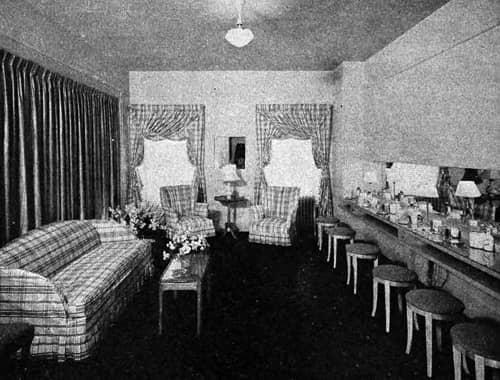
Above: 1943 Arden Powder Room in the St. Louis Service Women’s Center.
In 1943, using the idea that women were now busier with the war effort, Arden developed a series of ‘Efficiency Plans’ for her salons and a four ‘Efficiency Kits’ containing cosmetics suitable for Normal, Oily, Dry and Blemished skin types.
Start the New Year with an Elizabeth Arden Efficiency Plan. You, the builder, and Elizabeth Arden, the architect of the body, will work together on a project for perfection.
Plan A . . . 8 class lessons, plug private “Special Emphasis” treatments coordinate health and beauty building in a highly individualized program. You receive an Efficiency Kit containing the Essential for home care of the skin.
Plan B . . . a program of scientific relaxation plus time-saving personal grooming lor health and beauty . . . a face treatment, body massage, shampoo, wave, and manicure every week for 4 weeks.
Plan C . . . top-to-toe class instruction in new, swift methods of developing health, beauty, and good grooming; including an Efficiency Kit containing the Essentials for home care of the skin. Eight lessons.(Elizabeth Arden advertisement 1943)
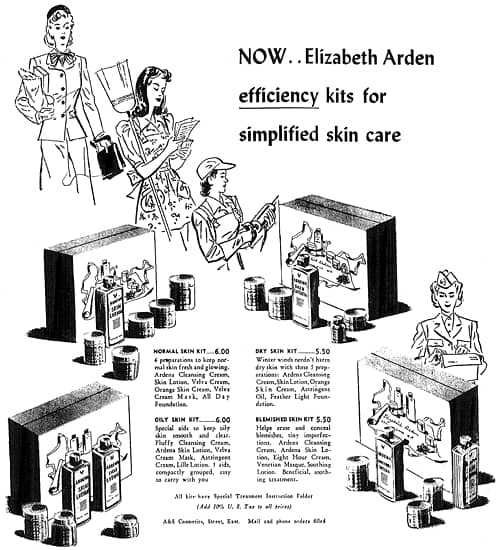
Above: 1943 Elizabeth Arden Efficiency Kits.
Normal: Ardena Cleansing Cream, Ardena Skin Lotion, Ardena Velva Cream, Orange Skin Cream, Velva Cream Mask, and All Day Foundation.
Oily: Fluffy Cleansing Cream, Ardena Skin Lotion, Velva Cream Mask, Astringent Cream, and Lille Lotion.
Dry: Ardena Cleansing Cream, Ardena Skin Lotion, Orange Skin Cream, Astringent Oil, and Feather Light Foundation.
Blemished: Ardena Cleansing Cream, Ardena Skin Lotion, Eight Hour Cream, Venetian Masque, and Soothing Lotion.
Designer clothes
A major development during the war years was Arden’s decision to get more seriously into fashion. The war had interrupted the Parisian domination of fashion and Arden appears to have decided it was an opportune time to add her own designer clothes. Arden had some experience in this field having sold lingerie, negligees, bags, jewellery and other items through her stores since the 1920s.
Woodworth and Lewis suggest an alternative reason for Arden getting into designer clothing, namely that it was a reaction to Hattie Carnegie [1886-1956] deciding to expand her custom-made and ready-to wear fashion business into cosmetics (Woodworth & Lewis, 1973, p. 218). There may be some truth to this but I should point out that Hattie Carnegie’s cosmetics line did not debut until 1945, some two years after Arden came to an arrangement with the English-American fashion designer Charles James to create clothes for her salon.
After some delays, Arden introduced a collection of Charles James’s creations at a Red Cross benefit fashion show staged in the Ritz-Carlton Hotel in April, 1944. Arden also worked with James to establish a fashion floor in the Aeolian Building in Fifth Avenue, New York – renamed the Elizabeth Arden Building after Arden bought the property in 1944. However, by 1945, the pair had fallen out leaving Arden with a fashion floor but without a designer.
Timeline
| 1930 | New York salon moved to 691 Fifth Avenue. New Washington salon opened. New Products: Spotpruf Lotion and Eight Hour Cream. |
| 1931 | Ardena Bath Treatment introduced. |
| 1932 | Three-in-One Treatment introduced. |
| 1933 | Elizabeth Arden Sales Corporation founded in New York. Philadelphia salon moved to South 17th Street. Los Angeles salon moved to Wilshire Boulevard. Elizabeth Arden Way to Beauty Radio program starts. Debutanté Treatment introduced. New Products: Ardena Sun-Pruf Cream; Ideal Suntan Oil; Velva Beauty Film; Ardena Cream Patter; and Venetian Velva Bath Mits. |
| 1934 | Elizabeth Arden G.m.b.H. established in Berlin. Elizabeth Arden S.A.I. established in Rome. Maine Chance spa/health farm opened. Sensation Treatment introduced. New Products: Ardena Astringent Cream; Blue Grass; Joie de Vivre Gland Cream; and Jewelled Automatic Lipstick. |
| 1935 | Elizabeth Arden (South America) Inc. established. DeLong Laboratories Ltd. acquired. New Products: Ardena Velva Mask Cream; Nail-O-Tonik Oil; Nail-O-Tonik Oil Enamel Polish; Cameo/Japonica Face Powder; Screen and Stage Make-up; and Slenderlines Reducing Lotion. |
| 1936 | Second salon opened in Los Angeles. Hair salon opened in the New York salon. New Products: Lille de France; Nail Protecto; Hand-O-Tonik; Pomade Blanche; Looking-Glass Lipstick; and Complexion Boxes. |
| 1937 | Gymnasium Moderne opened in the Fifth Avenue salon. Salon opened in Montreal. |
| 1938 | Salon opened in Honolulu. Intra-cellular Mask treatment introduced. Firmo-lift treatment introduced. New Products: Fluffy Cleansing Cream; Ardena Stimulash; and Ardena Face Moulder. |
| 1939 | Paris salon moves to 7 Place Vendôme. New British factory opened in North Acton. New Products: Ardena Ski-Sports Gelée; and All-Day Foundation Cream. |
| 1940 | New Products: Feather-Light Foundation Cream and Sleek depilatory. |
| 1941 | New Products: Velva Leg Film; Ardena Moisture Cream; and Filmofoam. |
| 1942 | New Products: Ardena Special Neck Cream. |
| 1944 | Aeolian Building purchased. Fashion floor opened in New York. Arden introduces her first designer label. |
Continued onto: Elizabeth Arden (post 1945)
First Posted: 29th October 2018
Last Update: 2nd March 2023
Sources
Allen, M. (1981). Selling dreams: Inside the beauty business. London: J. M. Dent & Sons Ltd.
Elizabeth Arden. (c.1932). Elizabeth Arden’s little book of instructions [Booklet]. USA: Author.
Elizabeth Arden. (c.1936). To tan or not to tan? [Brochure]. USA: Author.
Elizabeth Arden. (c.1936). Art in cosmetics [Brochure]. USA: Author.
Elizabeth Arden. (c.1937). The quest of the beautiful [Booklet]. UK: Author.
Elizabeth Arden. (c.1939). Foundations of beauty: A little book of instructions [Booklet]. USA: Author.
Elizabeth Arden. (1943). On the double [Booklet]. USA: Author.
Elizabeth Arden. (1944). Cleanse Refresh Smooth [Pamphlet]. USA: Author.
Elizabeth Arden. (c.1944). Why two powders are better than one [Brochure]. USA: Author.
Elizabeth Arden: Genius. (1938). American Perfumer & Essential Oil Review. October. pp. 35-36.
Federal Trade Commission decisions: Findings, orders and stipulations. June 1, 1938, to December 31, 1938. (1940). Volume 27. Washington: Government Printing Office.
Lewis, A. A., & Woodworth, C. (1973). Miss Elizabeth Arden. London: W. H. Allen.
Peiss, K. (1998). Hope in a jar: The making of America’s beauty culture. New York: Henry Holt and Company.
Shuker, N. (1989). Elizabeth Arden. Cometics entrepreneur. Englewood Cliffs, NJ: Silver Burdett Press.
Woodhead, L. (2003). War paint. Miss Elizabeth Arden and madame Helena Rubinstein their lives, their times, their rivalry. London: Virago Press.
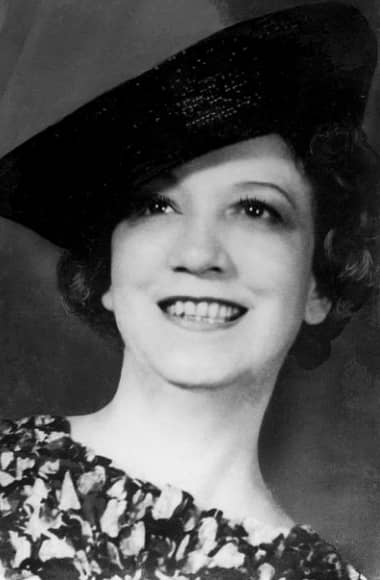
Florence Nightingale Graham [1881-1966] a.k.a. Elizabeth Arden.
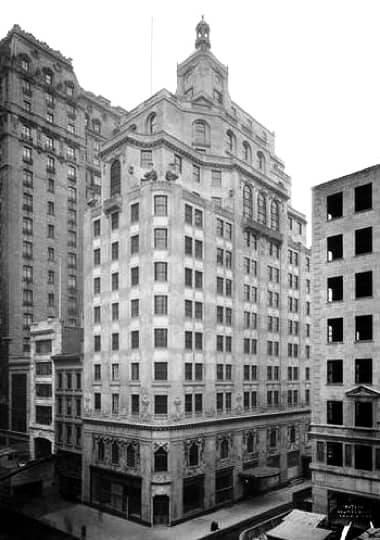
1927 The Aeolian Building just after completion. Designed by the architects Warren & Wetmore for the Gould Realty Company.
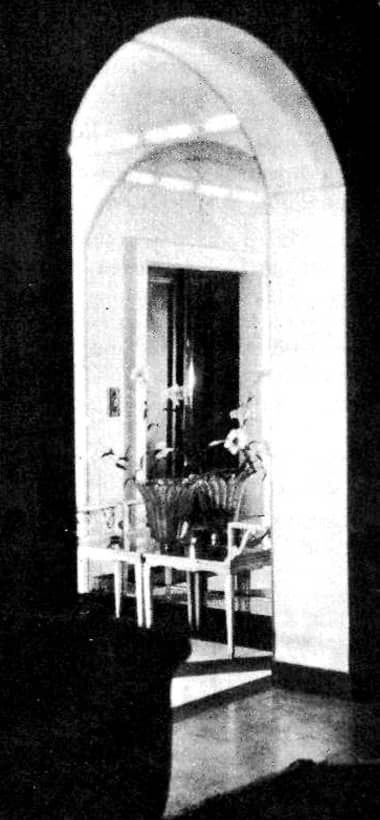
1931 Lobby in the Arden salon on Fifth Avenue.
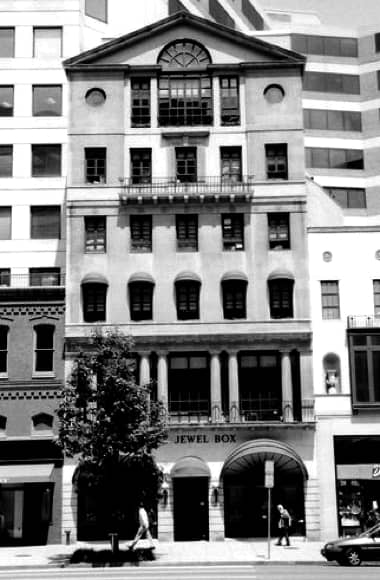
The Elizabeth Arden building at 1147 Connecticut Avenue, Washington D.C designed by the architect Mott B. Schmidt in the Georgian-revival style, competed in 1930. This photograph was taken after Elizabeth Arden had vacated the building in 1990.
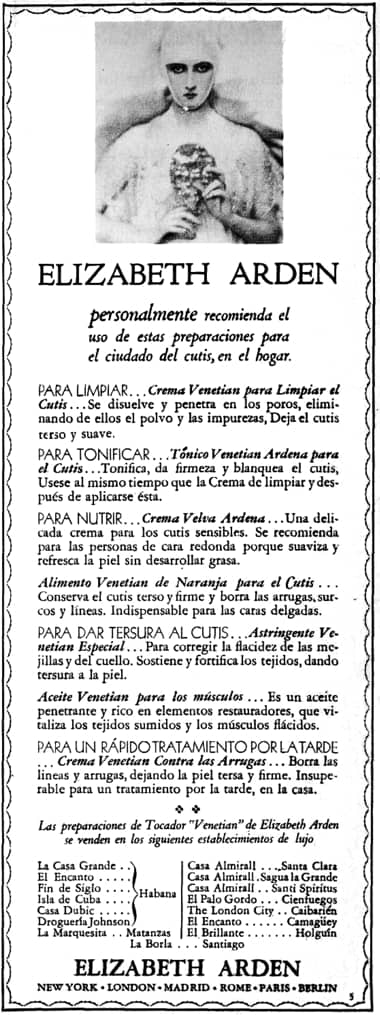
1930 Elizabeth Arden (Cuba).
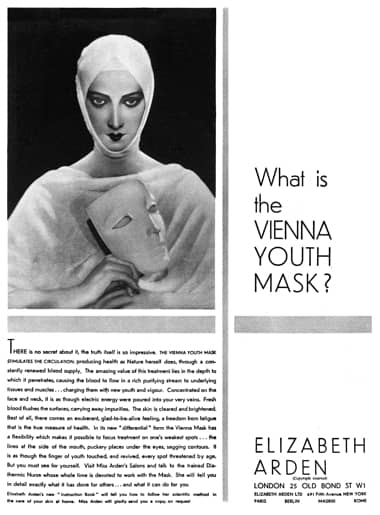
1931 Elizabeth Arden Vienna Youth Mask.
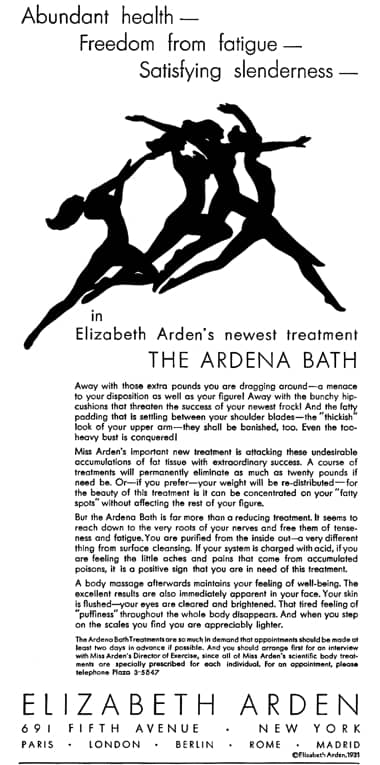
1931 Elizabeth Arden Ardena Bath.

1932 Elizabeth Arden Velva Bath, Velva Liquid, Milk of Almonds and Venetian Hand Cream.
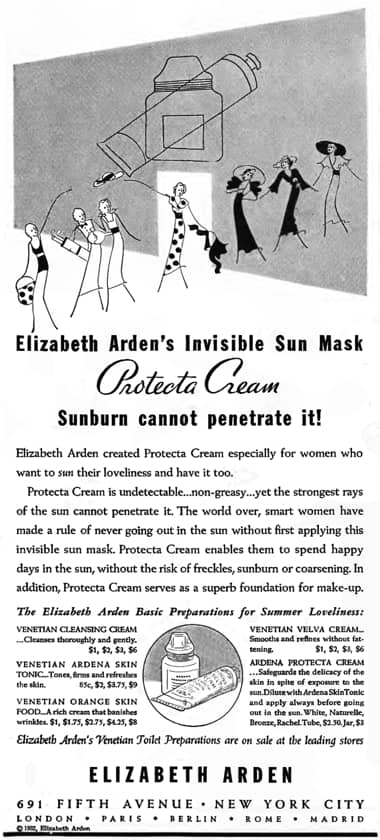
1932 Elizabeth Arden Protecta Cream.
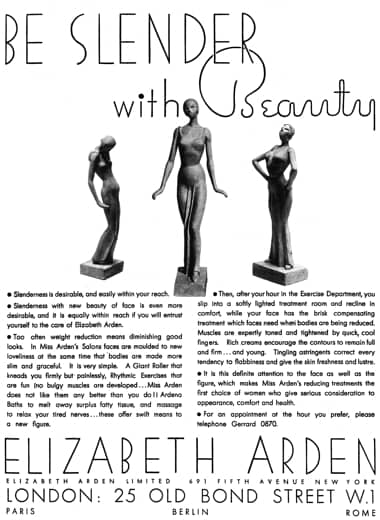
1932 Elizabeth Arden Slimming Treatments.

1933 Reception room at the Elizabeth Arden salon in Walton Place, Chicago.
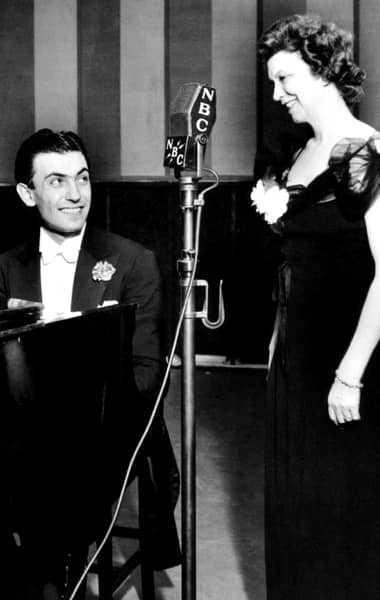
1933 Eddy Duchin [1909-1951] and Elizabeth Arden on NBC Radio.
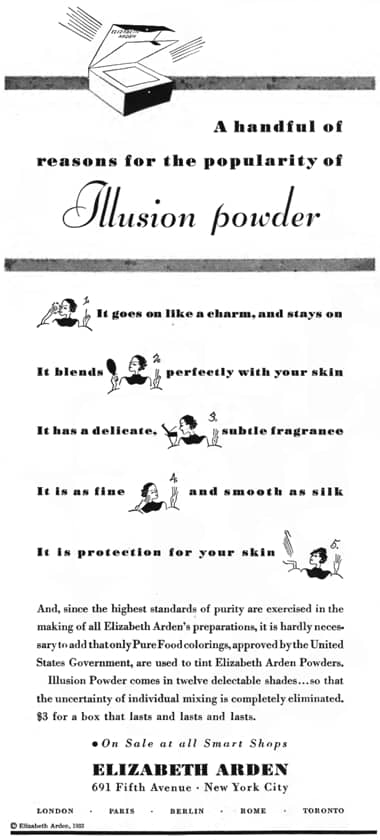
1933 Elizabeth Arden Illusion Powder.
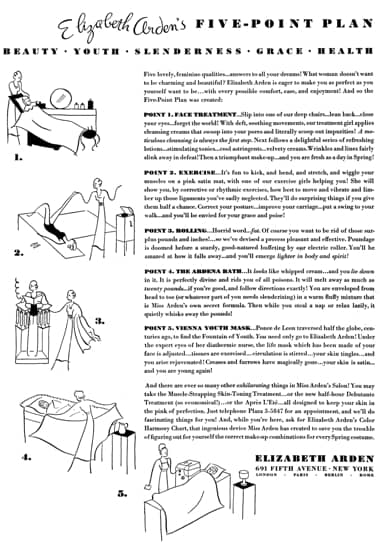
1933 Elizabeth Arden Five-Point Plan: 1. Face Treatment; 2. Exercise; 3. Rolling; 4. Ardena Bath; and 5. Vienna Youth Mask.
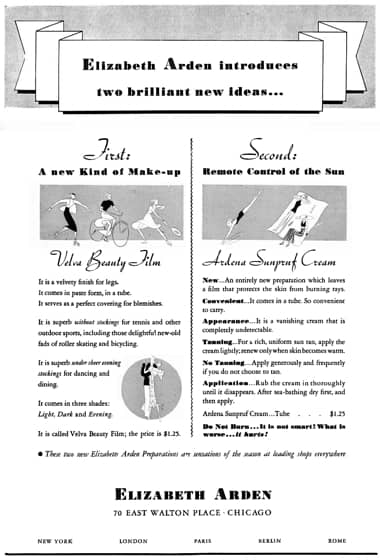
1933 Elizabeth Arden Velva Beauty Film and Ardena Sunpruf Cream.
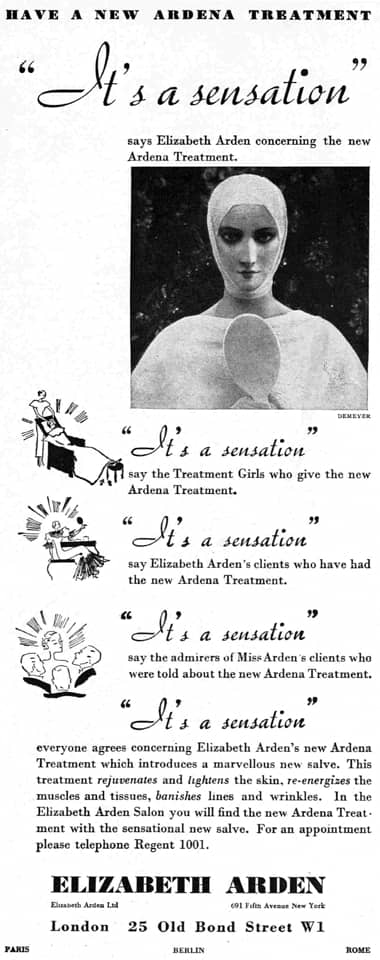
1933 Elizabeth Arden Sensation Treatment.
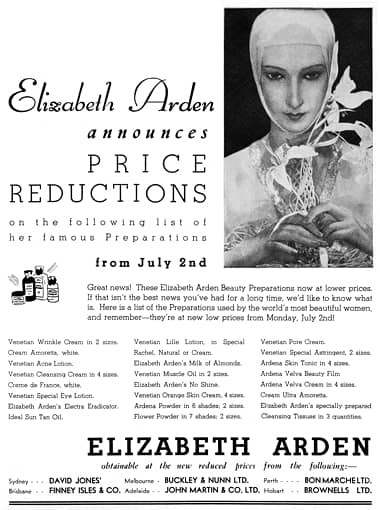
1934 Arden price reductions (Australia).
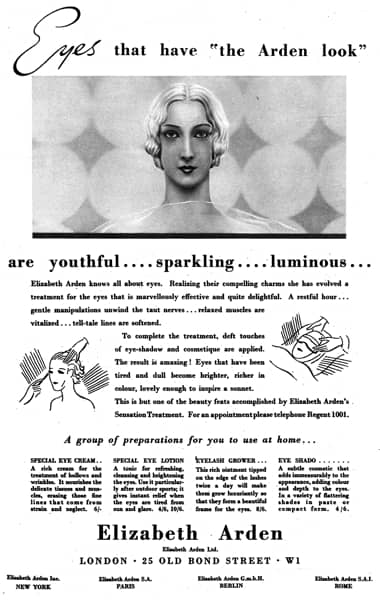
1934 Elizabeth Arden Eye Treatment. The face of Arden mannequin was frequently shown as unbandaged in the 1930s, a reflection of the increased amount of permanent waving done in Arden salons.
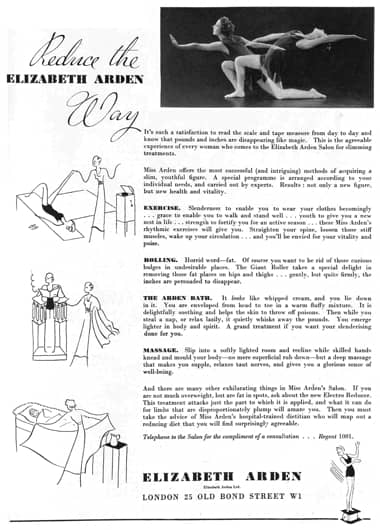
1935 Elizabeth Arden Reducing Treatments.

1935 Elizabeth Arden Blue Grass Perfume and Dusting Powder.

1935 Elizabeth Arden Gland Cream.

1935 Elizabeth Arden Sensation Salve.
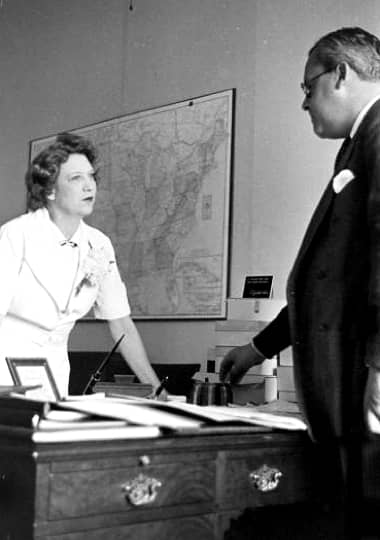
1936 Elizabeth Arden in her office with what appears to be her vice-president in charge of wholesale activities, Lawrence L. Schneider [1898-1979].
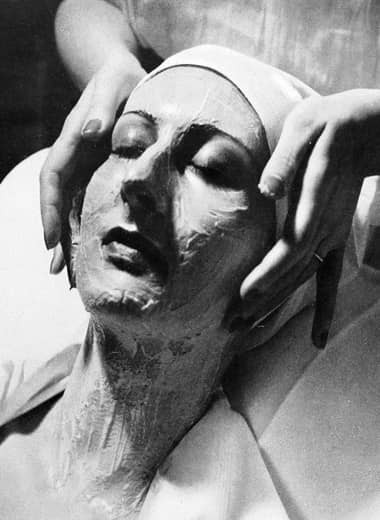
1936 Elizabeth Arden salon facial.
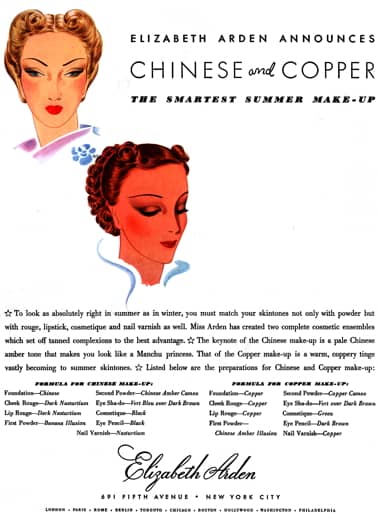
1936 Elizabeth Arden Chinese and Copper make-up.
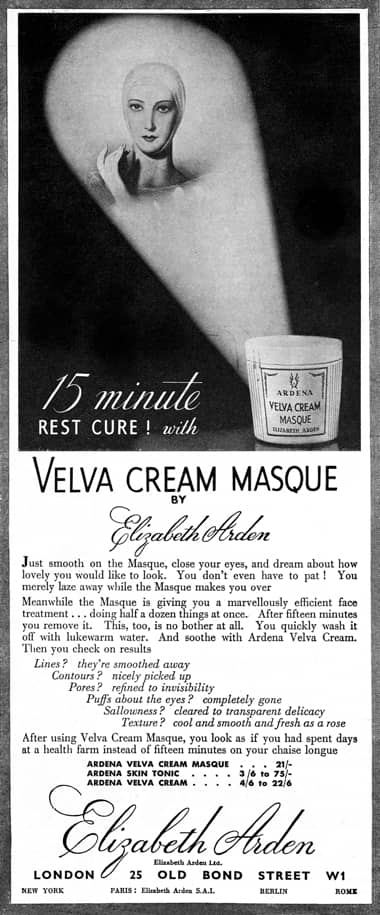
1936 Elizabeth Arden Velva Mask.
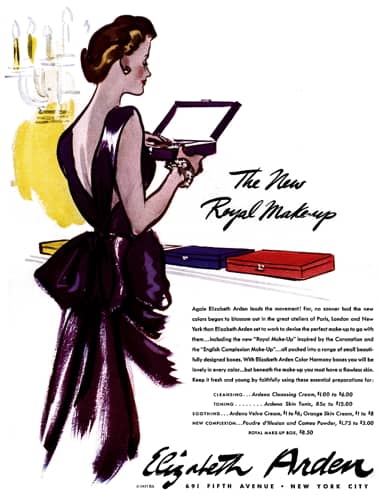
1937 Elizabeth Arden Royal Make-up in Colour Harmony Boxes.
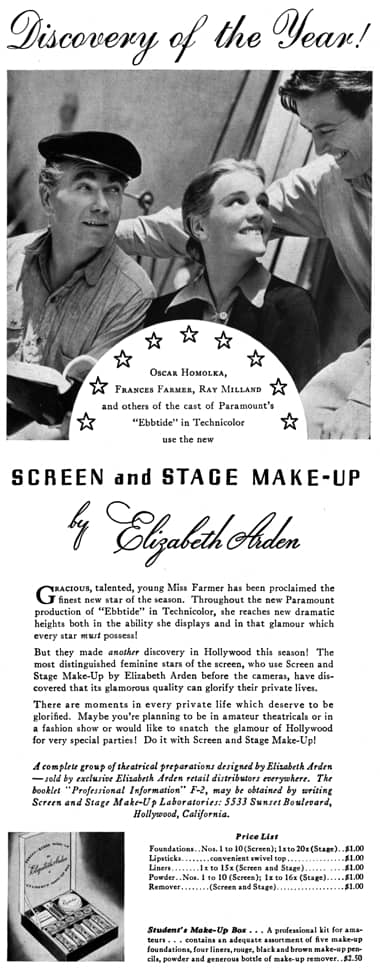
1937 Elizabeth Arden Screen and Stage Make-up.

1937 Elizabeth Arden Complexion Boxes containing two complementary powders.
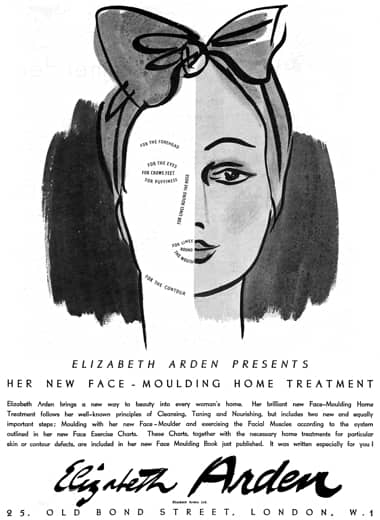
1938 Elizabeth Arden Face-Moulding Home Treatment.

1938 Elizabeth Arden Perfumes.
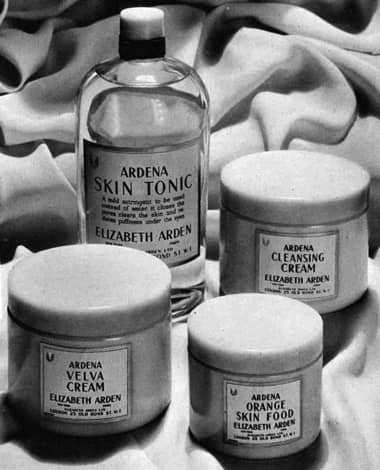
1938 Elizabeth Arden Ardena Skin Tonic, Velva Cream, Cleansing Cream and Orange Skin Food.
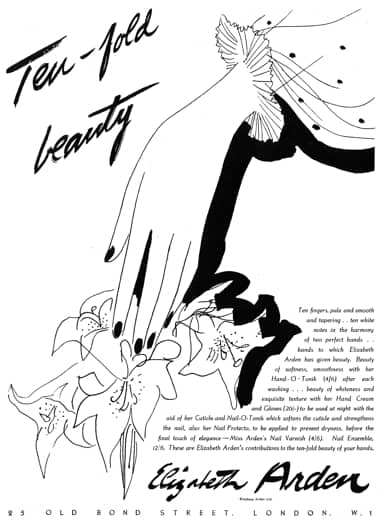
1938 Elizabeth Arden Nail Varnish, Hand-O-Tonic, Hand Cream and Gloves.
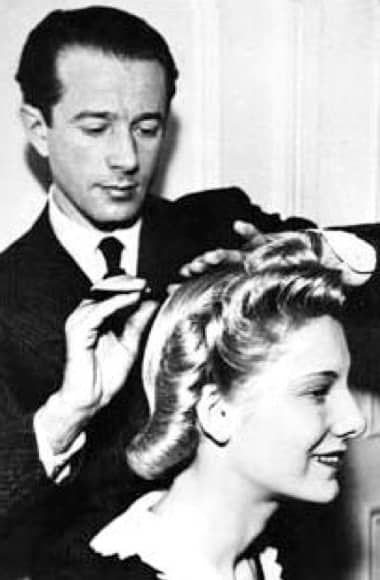
Guillaume Guglielmi [1903-1989]
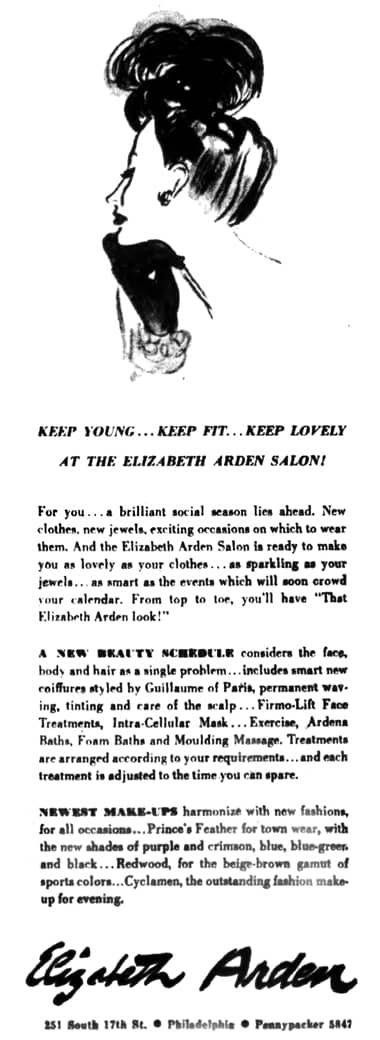
1938 Assorted treatments available through the Philadephia salon including coiffures styled by Guillaume of Paris.
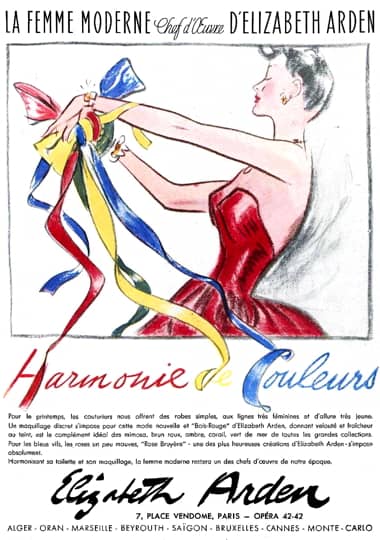
1939 Elizabeth Arden Harmonie Couleurs (Colour Harmony).
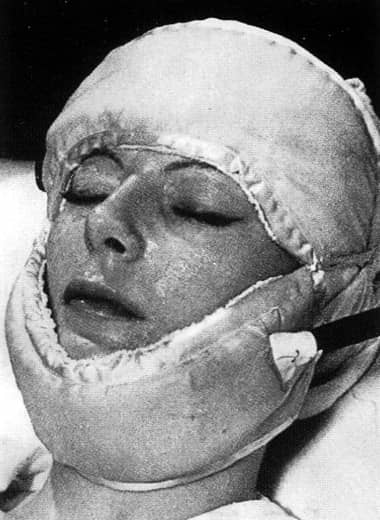
1939 Elizabeth Arden Intracellular Mask. The original version appears to have used a mask made for each client like those used in the Vienna Youth Mask. This version, made from pink silk, is flexible and could be used on anyone.
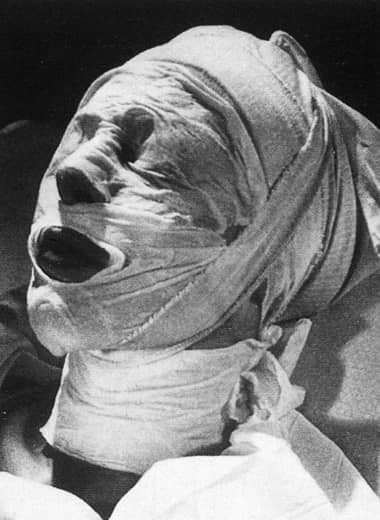
1939 Elizabeth Arden Firmo-Lift Face Treatment. The client’s face is bandaged in cheese-cloth soaked in Firmo-Lift Lotion.
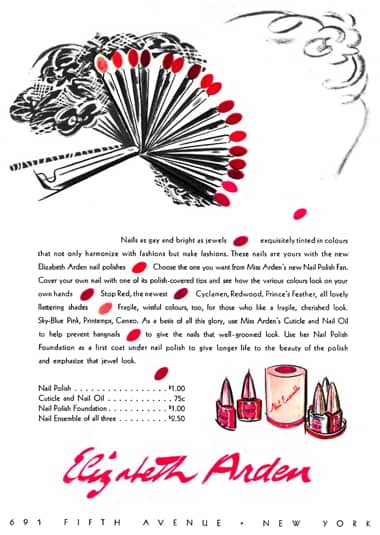
1939 Elizabeth Arden Nail Polish, Cuticle and Nail Oil, and Nail Polish Foundation.
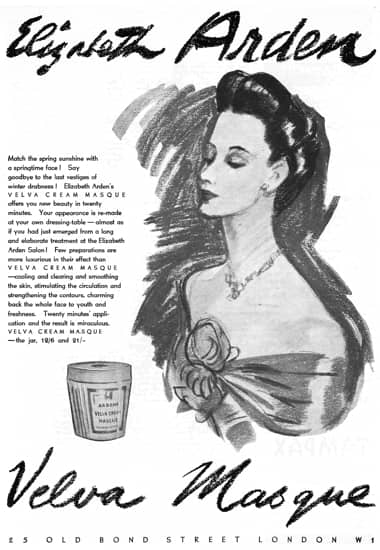
1939 Elizabeth Arden Velva Cream Mask.
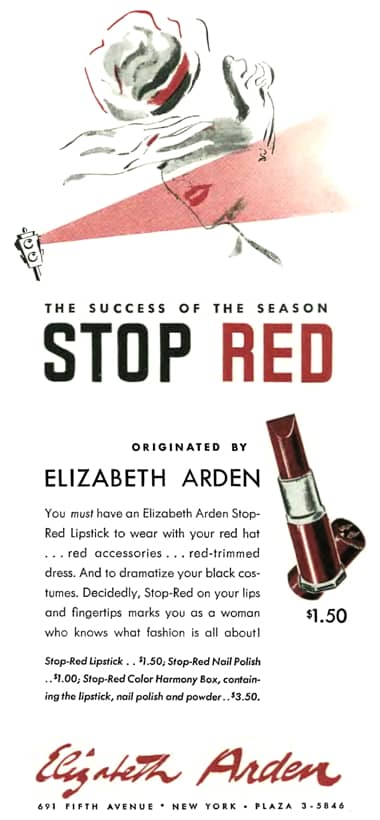
1939 Elizabeth Arden Stop Red.
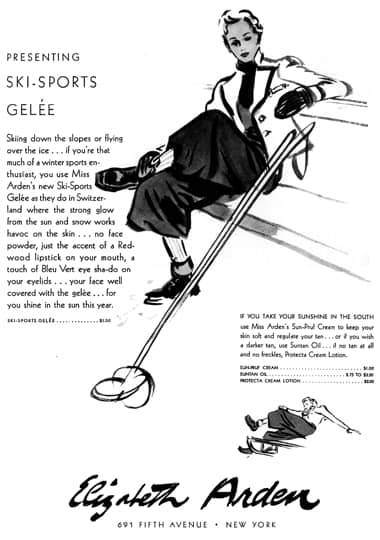
1939 Elizabeth Arden Ski-Sports Gelée.
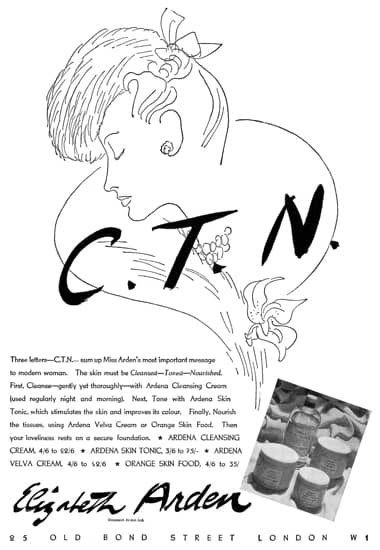
1939 Elizabeth Arden C.T.N. – Cleanse Tone Nourish.
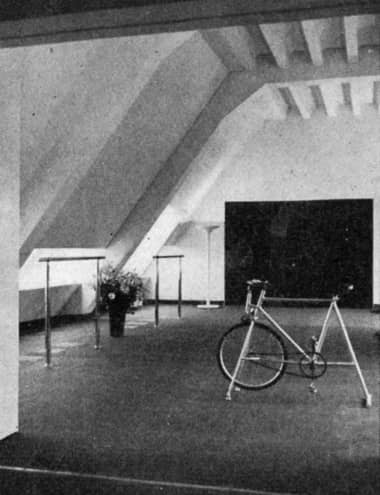
1939 Gymnasium in Elizabeth Arden’s Paris salon.
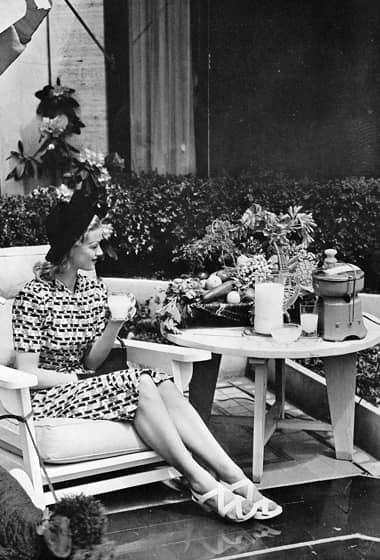
1939 Vitamin Bar in the rooftop garden of Elizabeth Arden’s Paris salon.

1940 Elizabeth Arden Foundations.
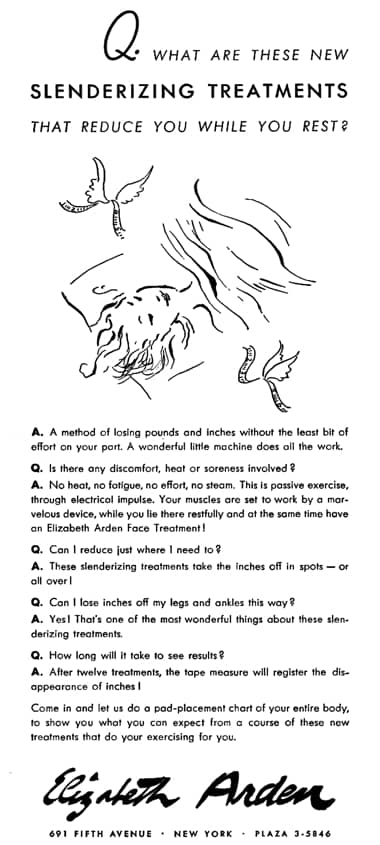
1940 Elizabeth Arden Slenderizing Treatments. The passive exercise treatments used electrical impulses to contract body muscles while the client rested.
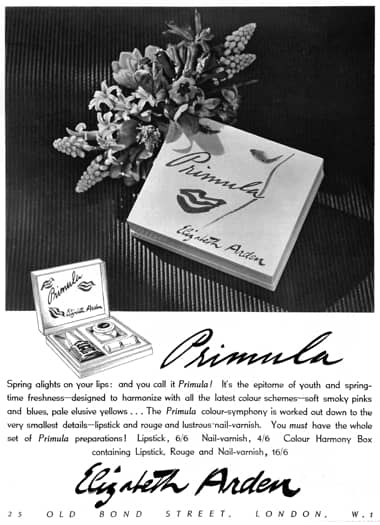
1940 Elizabeth Arden Primula.
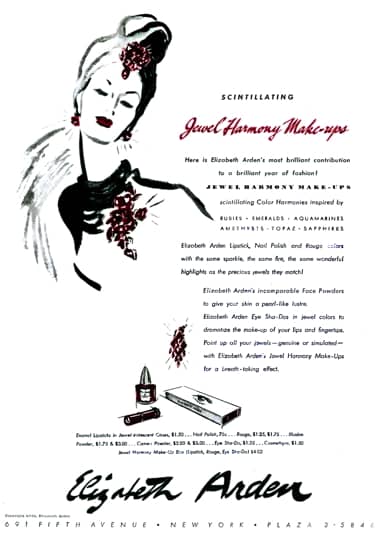
1940 Elizabeth Arden Jewel Harmony Make-up.
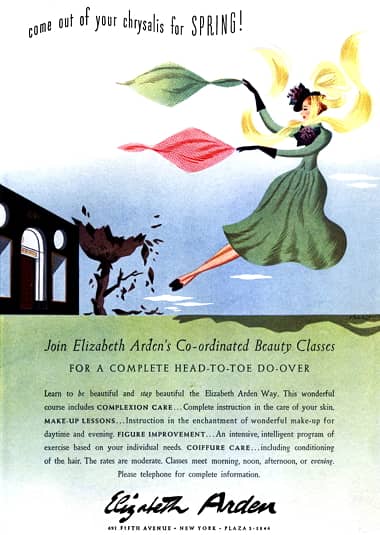
1940 Elizabeth Arden beauty classes.

1941 Elizabeth Arden Sunpruf Cream, Sports Geleé, Ideal Suntan Oil, Sleek, and Liquid Bronze Glo.

1941 Elizabeth Arden Protecta Cream, Suntan Oil and Ardena Sunpruf Cream (Australia).
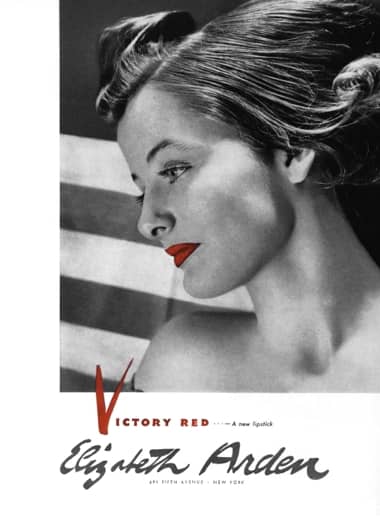
1941 Elizabeth Arden Victory Red.
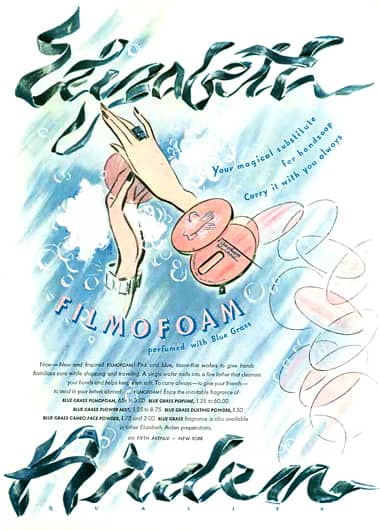
1941 Elizabeth Arden Filmofoam.
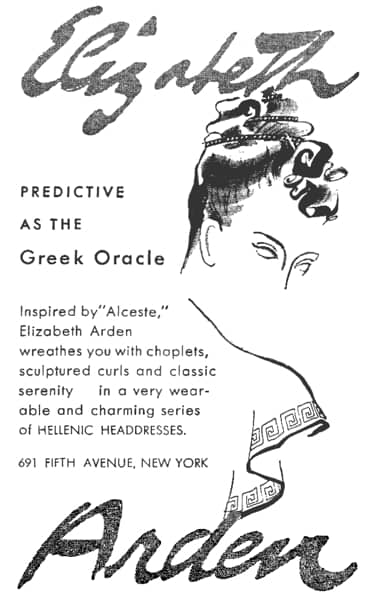
1941 Elizabeth Arden Hellenic Headdresses made with braids, curls and chignons of false hair.

1942 Elizabeth Arden treatments. As well as facials clients could engage in physical exercise programs, use the Giant Roller, undergo passive exercises strapped to an electrical machine, have an Ardena Wax Bath or a general body massage.
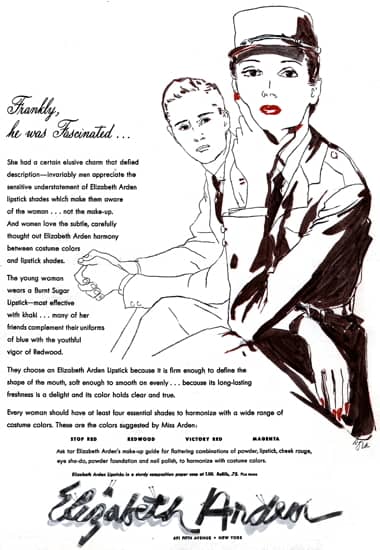
1942 Elizabeth Arden lipstick shades for service women.
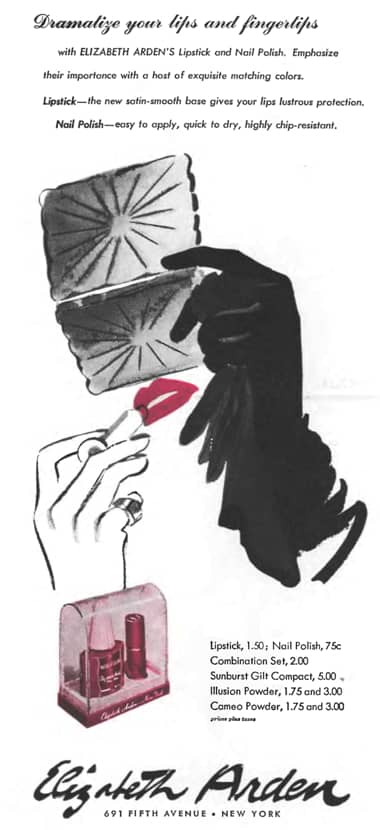
1942 Elizabeth Arden Nail Varnish.
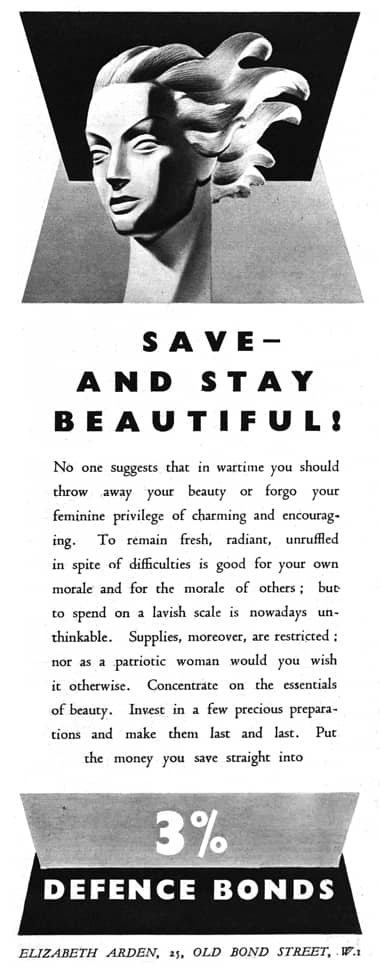
1943 Elizabeth Arden save money for defence bonds.
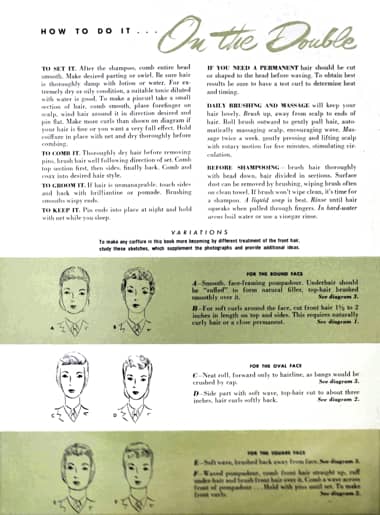
1943 Elizabeth Arden ‘On the Double’. Part of a booklet on hair and make-up advice for service women.
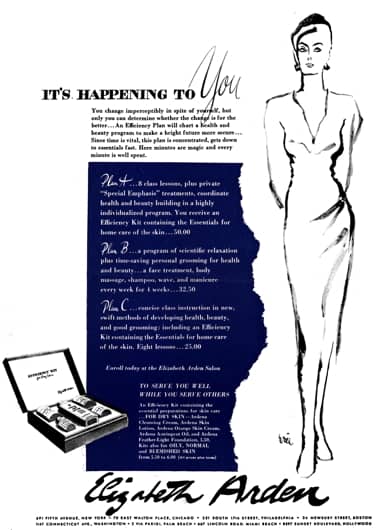
1943 Elizabeth Arden ‘It’s Happening to You’. Arden ‘Efficiency Plans’ to prepare women for their new roles during the war.
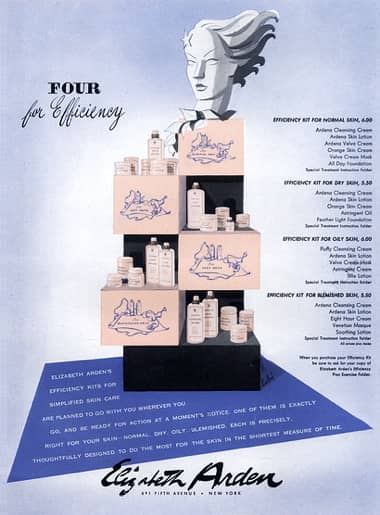
1943 Elizabeth Arden Efficiency Kits for Normal, Oily, Dry and Blemished skin types.
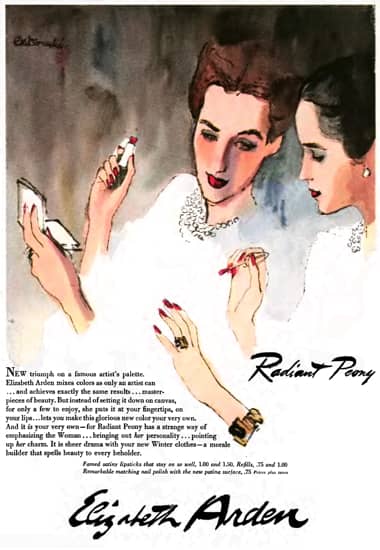
1943 Elizabeth Arden Radiant Peony.
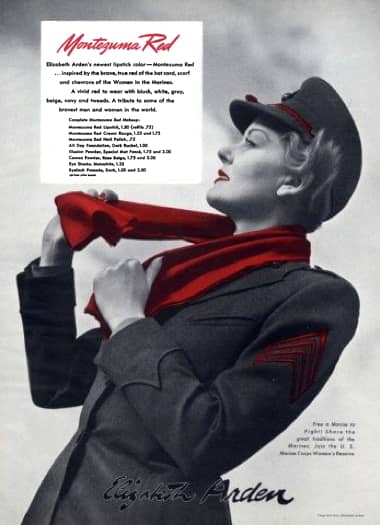
1944 Elizabeth Arden Montezuma Red toned to match the red braid used on the hat.
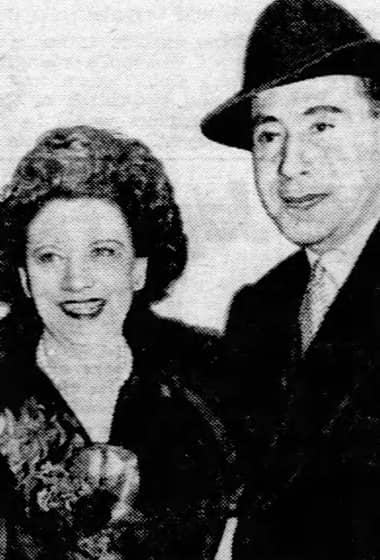
Princess Elizabeth Nightingale Evlanoff (a.k.a Elizabeth Arden) and Prince Michael Evlanoff [1894-1972]. Arden divorced him in February, 1944.
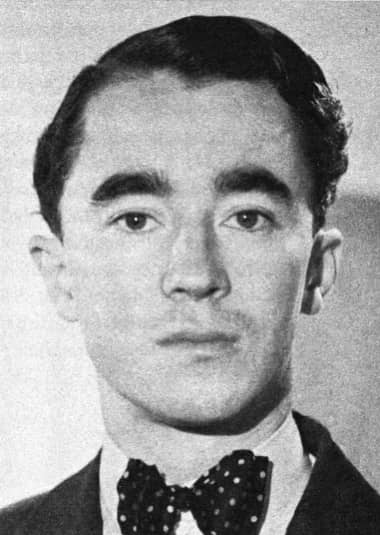
Charles James [1906-1978] .
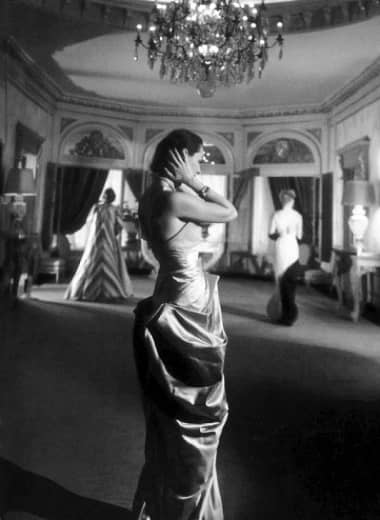
1944 Fashion floor developed by Charles James in the Elizabeth Arden Building.

1945 Elizabeth Arden All-Day Foundation.
